软件测试计划(STP)
[汇总]软件开发项目文档资料清单
![[汇总]软件开发项目文档资料清单](https://img.taocdn.com/s3/m/4356f832cec789eb172ded630b1c59eef8c79a3e.png)
软件开发项目文档资料清单:1、可行性分析(研究)报告(FAR):由建设单位或建设单位委托有咨询资质的单位编写。
2、软件开发计划(SPP):其中可包括以下项目,或视需要将以下项单独编制成册:1.软件配置管理计划(SCMPP)2.软件质量保证计划(SQAP)3.用户培训计划4.软件安装(部署)计划3、项目详细实施方案。
4、软件需求规格说明书(SRS):需对接口设计说明,如需要可用接口需求规格说明书(IRS)加以补充,并包括业务数据流图和数据字典。
5、数据需求说明书(DRD)6、概要设计说明书(PDD)7、详细设计说明书(DDD):可放在最后编写(包括接口设计说明(IDD)和数据库设计说明书(DBDD))。
8、软件测试计划(STP)9、软件测试说明(STD):其中包括测试用例和测试过程。
10、软件测试报告(STR):分为综合测试报告和验收测试报告,如需要可提交软件测试日志。
11、用户手册(SUM):包括操作,使用,安装,应急处理,维护。
12、开发进度月报(DPMR)。
13、试运行方案。
14、软件维护报告。
15、软件部署说明书。
16、售后服务保证文件。
17、知识产权说明、交付使用授权书18、源程序(SCL):不可修改的电子文档及相关介质。
19、软件验收测试大纲。
20、系统试运行报告,用户使用报告。
21、项目开发总结报告(PDSR)。
22、其他类文档:1.开发合同或协议的复印件2.项目经理任命书3.开工申请4.内部测试报告(主要检查承建方是否进行内部测试)。
软件测试计划模板-英文版
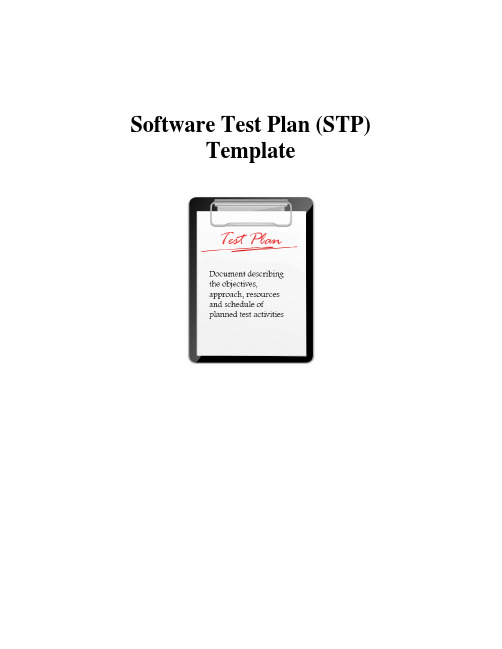
Software Test Plan (STP)Template1. INTRODUCTIONThe Introduction section of the Software Test Plan (STP) provides an overview of the project and the product test strategy, a list of testing deliverables, the plan for development and evolution of the STP, reference material, and agency definitions and acronyms used in the STP.The Software Test Plan (STP) is designed to prescribe the scope, approach, resources, and schedule of all testing activities. The plan must identify the items to be tested, the features to be tested, the types of testing to be performed, the personnel responsible for testing, the resources and schedule required to complete testing, and the risksassociated with the plan.1.1 Objectives(Describe, at a high level, the scope, approach, resources, and schedule of thetesting activities. Provide a concise summary of the test plan objectives, theproducts to be delivered, major work activities, major work products, majormilestones, required resources, and master high-level schedules, budget, andeffort requirements.)1.2 Testing StrategyTesting is the process of analyzing a software item to detect the differencesbetween existing and required conditions and to evaluate the features of thesoftware item. (This may appear as a specific document (such as a TestSpecification), or it may be part of the organization's standard test approach. Foreach level of testing, there should be a test plan and an appropriate set ofdeliverables. The test strategy should be clearly defined and the Software TestPlan acts as the high-level test plan. Specific testing activities will have their owntest plan. Refer to section 5 of this document for a detailed list of specific testplans.)Specific test plan components include:∙Purpose for this level of test,∙Items to be tested,∙Features to be tested,∙Features not to be tested,∙Management and technical approach,∙Pass / Fail criteria,∙Individual roles and responsibilities,∙Milestones,∙Schedules, and∙Risk assumptions and constraints.1.3 Scope(Specify the plans for producing both scheduled and unscheduled updates to theSoftware Test Plan (change management). Methods for distribution of updatesshall be specified along with version control and configuration managementrequirements must be defined.)Testing will be performed at several points in the life cycle as the product isconstructed. Testing is a very 'dependent' activity. As a result, test planningis a continuing activity performed throughout the system development lifecycle. Test plans must be developed for each level of product testing.1.4 Reference Material(Provide a complete list of all documents and other sources referenced in theSoftware Test Plan. Reference to the following documents (when they exist) isrequired for the high-level test plan:∙Project authorization,∙Project plan,∙Quality assurance plan,∙Configuration management plan,∙Organization policies and procedures, and∙Relevant standards.)1.5 Definitions and Acronyms(Specify definitions of all terms and agency acronyms required to properlyinterpret the Software Test Plan. Reference may be made to the Glossary of Termson the IRMC web page.)2. TEST ITEMS(Specify the test items included in the plan. Supply references to the following itemdocumentation:∙Requirements specification,∙Design specification,∙Users guide,∙Operations guide,∙Installation guide,∙Features (availability, response time),∙Defect removal procedures, and∙Verification and validation plans.)2.1 Program Modules(Outline testing to be performed by the developer for each module being built.)2.2 Job Control Procedures(Describe testing to be performed on job control language (JCL), productionscheduling and control, calls, and job sequencing.)2.3 User Procedures(Describe the testing to be performed on all user documentation to ensure thatit is correct, complete, and comprehensive.)2.4 Operator Procedures(Describe the testing procedures to ensure that the application can be run andsupported in a production environment (include Help Desk procedures)). 3. FEATURES TO BE TESTED(Identify all software features and combinations of software features to be tested. Identify the test design specifications associated with each feature and each combination of features.) 4. FEATURES NOT TO BE TESTED(Identify all features and specific combinations of features that will not be tested along with the reasons.)5. APPROACH(Describe the overall approaches to testing. The approach should be described in sufficient detail to permit identification of the major testing tasks and estimation of the time required to do each task. Identify the types of testing to be performed along with the methods and criteria to be used in performing test activities. Describe the specific methods and procedures for each type of testing. Define the detailed criteria for evaluating the test results.)(For each level of testing there should be a test plan and the appropriate set of deliverables.Identify the inputs required for each type of test. Specify the source of the input. Also, identify the outputs from each type of testing and specify the purpose and format for each test output.Specify the minimum degree of comprehensiveness desired. Identify the techniques that will be used to judge the comprehensiveness of the testing effort. Specify any additionalcompletion criteria (e.g., error frequency). The techniques to be used to trace requirements should also be specified.)5.1 Component Testing(Testing conducted to verify the implementation of the design for one softwareelement (e.g., unit, module) or a collection of software elements. Sometimes calledunit testing. The purpose of component testing is to ensure that the program logicis complete and correct and ensuring that the component works as designed.)5.2 Integration Testing(Testing conducted in which software elements, hardware elements, or both arecombined and tested until the entire system has been integrated. The purpose ofintegration testing is to ensure that design objectives are met and ensures that thesoftware, as a complete entity, complies with operational requirements.Integration testing is also called System Testing.)5.3 Conversion Testing(Testing to ensure that all data elements and historical data is converted from anold system format to the new system format.)5.4 Job Stream Testing(Testing to ensure that the application operates in the production environment.)5.5 Interface Testing(Testing done to ensure that the application operates efficiently and effectivelyoutside the application boundary with all interface systems.)5.6 Security Testing(Testing done to ensure that the application systems control and auditabilityfeatures of the application are functional.)5.7 Recovery Testing(Testing done to ensure that application restart and backup and recovery facilities operate as designed.)5.8 Performance Testing(Testing done to ensure that that the application performs to customerexpectations (response time, availability, portability, and scalability)).5.9 Regression Testing(Testing done to ensure that that applied changes to the application have notadversely affected previously tested functionality.)5.10 Acceptance Testing(Testing conducted to determine whether or not a system satisfies the acceptancecriteria and to enable the customer to determine whether or not to accept thesystem. Acceptance testing ensures that customer requirements' objectives are met and that all components are correctly included in a customer package.)5.11 Beta Testing(Testing, done by the customer, using a pre-release version of the product toverify and validate that the system meets business functional requirements. Thepurpose of beta testing is to detect application faults, failures, and defects.)6. PASS / FAIL CRITERIA(Specify the criteria to be used to determine whether each item has passed or failedtesting.)6.1 Suspension Criteria(Specify the criteria used to suspend all or a portion of the testing activity on testitems associated with the plan.)6.2 Resumption Criteria(Specify the conditions that need to be met to resume testing activities aftersuspension. Specify the test items that must be repeated when testing is resumed.)6.3 Approval Criteria(Specify the conditions that need to be met to approve test results. Define theformal testing approval process.)7. TESTING PROCESS(Identify the methods and criteria used in performing test activities. Define the specificmethods and procedures for each type of test. Define the detailed criteria for evaluatingtest results.)7.1 Test Deliverables(Identify the deliverable documents from the test process. Test input and outputdata should be identified as deliverables. Testing report logs, test incident reports,test summary reports, and metrics' reports must be considered testingdeliverables.)7.2 Testing Tasks(Identify the set of tasks necessary to prepare for and perform testing activities.Identify all intertask dependencies and any specific skills required.)7.3 Responsibilities(Identify the groups responsible for managing, designing, preparing, executing,witnessing, checking, and resolving test activities. These groups may include thedevelopers, testers, operations staff, technical support staff, data administrationstaff, and the user staff.)7.4 Resources(Identify the resources allocated for the performance of testing tasks. Identify theorganizational elements or individuals responsible for performing testingactivities. Assign specific responsibilities. Specify resources by category. Ifautomated tools are to be used in testing, specify the source of the tools,availability, and the usage requirements.)7.5 Schedule(Identify the high level schedule for each testing task. Establish specificmilestones for initiating and completing each type of test activity, for thedevelopment of a comprehensive plan, for the receipt of each test input, and forthe delivery of test output. Estimate the time required to do each test activity.)(When planning and scheduling testing activities, it must be recognized that thetesting process is iterative based on the testing task dependencies.)8. ENVIRONMENTAL REQUIREMENTS(Specify both the necessary and desired properties of the test environment including the physical characteristics, communications, mode of usage, and testing supplies. Also provide the levels of security required to perform test activities. Identify special test tools needed and other testing needs (space, machine time, and stationary supplies. Identify the source of all needs that is not currently available to the test group.)8.1 Hardware(Identify the computer hardware and network requirements needed to completetest activities.)8.2 Software(Identify the software requirements needed to complete testing activities.)8.3 Security(Identify the testing environment security and asset protection requirements.)8.4 Tools(Identify the special software tools, techniques, and methodologies employed inthe testing efforts. The purpose and use of each tool shall be described. Plans forthe acquisition, training, support, and qualification for each tool or technique.)8.5 Publications(Identify the documents and publications that are required to support testingactivities.)8.6 Risks and Assumptions(Identify significant constraints on testing such as test item availability, testresource availability, and time constraints. Identify the risks and assumptionsassociated with testing tasks including schedule, resources, approach anddocumentation. Specify a contingency plan for each risk factor.)(Identify the software test plan change management process. Define the change initiation, change review, and change authorization process.)10. PLAN APPROVALS(Identify the plan approvers. List the name, signature and date of plan approval.)。
438b-软件测试计划

软件测试计划说明书第1章范围1.1标识本节应包含本文档适用的系统和软件的完整标识,(若适用)包括标识号、名称、缩略名、版本号、发布号。
1.2系统概述本节概述本文档适用的系统和软件的用途。
它应描述系统与软件的一般性质;概述系统开发、运行和维护的历史;标识项目的投资方、需方、用户、开发方和保障机构;标识当前和计划的运行现场;并列出其它有关文档。
1.3文档概述本节应概括本文档的用途和内容,描述与其使用有关的保密性或私密性考虑。
1.4与其它计划的关系本节应描述本计划(STP)与其他项目管理计划之间的关系(若有)。
第2章引用文档本章应列出本文档引用的所有文档的编号、标题、修订版本和日期。
本章也应标识不能通过正常供货渠道获得的文档的来源。
第3章软件测试环境3.1(测试现场名称)3.1.1软件项(若适用)本节应按名称、编号和版本,标识在测试现场执行计划中的测试活动所需的软件项(如操作系统、编译程序、通信软件、有关的应用软件、数据库、输入文件、代码检查程序、动态路径分析程序、测试驱动程序、预处理程序、测试数据产生程序、测试控制软件、其它专用测试软件、后处理器程序)。
本节还应描述每个软件项的用途,说明它的介质(磁带、磁盘等),标识那些期望现场提供的软件项,标识与软件项有关的保密处理或其它保密性与私密性问题。
3.1.23.x.2 硬件和固件项(若适用)本节应按名称、编号和版本标识在测试现场的软件测试环境中使用的计算机硬件、接口设备、通信设备、测试数据简约设备、另外的外围设备(磁带机、打印机、绘图议)、测试消息生成器、测试计时设备、测试事件记录仪等装置和固件项。
本节应描述每项的用途,陈述所需每项的使用时间与数量,标识那些期望现场提供的项,标识与这些硬件及固件项有关的保密处理或其它保密性与私密性问题。
3.1.33.x.3 其它材料本节应标识并描述在测试现场执行测试所需的任何其它材料。
这些材料可包括手册、软件清单、被测试软件的介质、测试用数据的介质、输出的样本清单和其它表格或说明。
测试具体内容

测试具体内容测试内容应该包括:合法性检查、文档检查、软件一致性检查、软件系统测试与测试结果评审等几项工作。
1、合法性检查检查开发者在开发本软件时,使用的开发工具是否合法。
对在编程中使用的一些非本单位自己开发的,也不是由开发工具提供的控件、组件、函数库等,检查其是否有合法的发布许可。
2、软件文档检查必须提供检查的文档项目实施计划;详细技术方案;软件需求规格说明书(STP)(含数据字典);概要设计说明书(PDD);详细设计说明书(DDD)(含数据库设计说明书);软件测试计划(STP)(含测试用例);软件测试报告(STR);用户手册(SUM)(含操作、使用、维护、应急处理手册);源程序(SCL)(不可修改的电子文档);项目实施计划(PIP);项目开发总结(PDS);软件质量保证计划(SQAP);其他可能需要检查的文档软件配置计划(SCMPP);项目进展报表(PPR);阶段评审报表(PRR);由业主确定必须检查的其他文档说明:如果业主认为4.1.1节和4.1.2节所列文档之外,还需要检查其它文档,则在此列出文档名称;如果业主认为不需要进行额外的文档检查,则本部分无内容。
文档质量的度量准则文档是软件的重要组成都分,是软件生存周期各个不同阶段的产品描述。
文档质量的度量准则就是要评审各阶段文档的合适性。
主要有以下六条:完备性开发方必须按照GB 8567(计算机软件产品开发文件编制指南)的规定编制相应的文档,以保证在开发阶段结束时其文档是齐全的。
正确性在软件开发各个阶段所编写的文档的内容,必须真实的反映阶段的工作且与该阶段的需求相一致。
简明性在软件开发各个阶段所编写的各种文档的语言表达应该清晰、准确简练,适合各种文档的特定读者。
可追踪性在软件开发各个阶段所编写的各种文档应该具有良好的可追踪性。
文档的可追踪性包括横向可追踪性和纵向可追踪性两个方面。
前者是指在不同的文档的相关内容之间相互检索的难易程序;后者是指确定同一文档某一内容在本文档范围中检索的难易程度。
软件测试计划
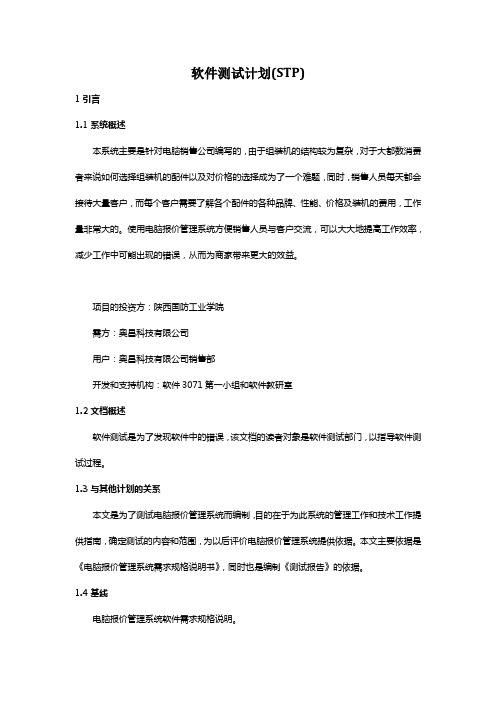
软件测试计划(STP)1引言1.1系统概述本系统主要是针对电脑销售公司编写的,由于组装机的结构较为复杂,对于大都数消费者来说如何选择组装机的配件以及对价格的选择成为了一个难题,同时,销售人员每天都会接待大量客户,而每个客户需要了解各个配件的各种品牌、性能、价格及装机的费用,工作量非常大的。
使用电脑报价管理系统方便销售人员与客户交流,可以大大地提高工作效率,减少工作中可能出现的错误,从而为商家带来更大的效益。
项目的投资方:陕西国防工业学院需方:奥昌科技有限公司用户:奥昌科技有限公司销售部开发和支持机构:软件3071第一小组和软件教研室1.2文档概述软件测试是为了发现软件中的错误,该文档的读者对象是软件测试部门,以指导软件测试过程。
1.3与其他计划的关系本文是为了测试电脑报价管理系统而编制,目的在于为此系统的管理工作和技术工作提供指南,确定测试的内容和范围,为以后评价电脑报价管理系统提供依据。
本文主要依据是《电脑报价管理系统需求规格说明书》,同时也是编制《测试报告》的依据。
1.4基线电脑报价管理系统软件需求规格说明。
2引用文件计算机软件文档编制规范(GB、T 8567-2006),2006年3月14日发布,2006年7月1日实施。
3软件测试环境测试地点:陕西国防工业学院软件教研室测试环境:硬件环境:普通办公用个人计算机操作系统:采用Windows XP系统数据库系统:SQL Server 2000数据库4计划4.1.1测试方案采用以黑盒测试为主、白盒测试为辅的测试方式,检查电脑报价管理系统各模块的输入、输出等是否符合需求中的要求,并检查系统对异常情况的承受能力。
4.1.2测试条目1.建立并维护全部供应商信息的测试2.建立并维护全部客户信息的测试3. 建立并维护配件品牌及配件类型信息的测试4 建立并维护配件信息的测试5.配置详单生成及维护功能测试6.配置单管理功能测试7.推荐配置单管理功能测试8.装机时推荐配置单应用功能测试。
软件测试英语术语 缩写
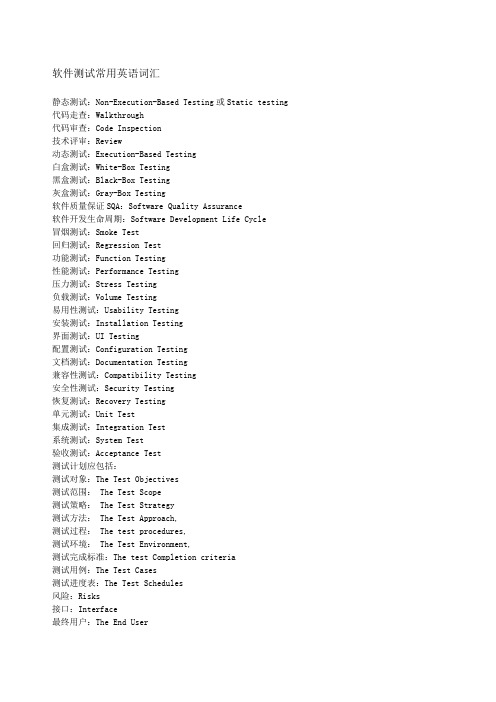
软件测试常用英语词汇静态测试:Non-Execution-Based Testing或Static testing 代码走查:Walkthrough代码审查:Code Inspection技术评审:Review动态测试:Execution-Based Testing白盒测试:White-Box Testing黑盒测试:Black-Box Testing灰盒测试:Gray-Box Testing软件质量保证SQA:Software Quality Assurance软件开发生命周期:Software Development Life Cycle冒烟测试:Smoke Test回归测试:Regression Test功能测试:Function Testing性能测试:Performance Testing压力测试:Stress Testing负载测试:Volume Testing易用性测试:Usability Testing安装测试:Installation Testing界面测试:UI Testing配置测试:Configuration Testing文档测试:Documentation Testing兼容性测试:Compatibility Testing安全性测试:Security Testing恢复测试:Recovery Testing单元测试:Unit Test集成测试:Integration Test系统测试:System Test验收测试:Acceptance Test测试计划应包括:测试对象:The Test Objectives测试范围: The Test Scope测试策略: The Test Strategy测试方法: The Test Approach,测试过程: The test procedures,测试环境: The Test Environment,测试完成标准:The test Completion criteria测试用例:The Test Cases测试进度表:The Test Schedules风险:Risks接口:Interface最终用户:The End User正式的测试环境:Formal Test Environment确认需求:Verifying The Requirements有分歧的需求:Ambiguous Requirements运行和维护:Operation and Maintenance.可复用性:Reusability可靠性: Reliability/Availability电机电子工程师协会IEEE:The Institute of Electrical and Electronics Engineers) 正确性:Correctness实用性:Utility健壮性:Robustness可靠性:Reliability软件需求规格说明书:SRS (software requirement specification )概要设计:HLD (high level design )详细设计:LLD (low level design )统一开发流程:RUP (rational unified process )集成产品开发:IPD (integrated product development )能力成熟模型:CMM (capability maturity model )能力成熟模型集成:CMMI (capability maturity model integration )戴明环:PDCA (plan do check act )软件工程过程组:SEPG (software engineering process group )集成测试:IT (integration testing )系统测试:ST (system testing )关键过程域:KPA (key process area )同行评审:PR (peer review )用户验收测试:UAT (user acceptance testing )验证和确认:V&V (verification & validation )控制变更委员会:CCB (change control board )图形用户界面:GUI (graphic user interface )配置管理员:CMO (configuration management officer )平均失效间隔时间:(MTBF mean time between failures )平均修复时间:MTTR (mean time to restoration )平均失效时间:MTTF (mean time to failure )工作任务书:SOW (statement of work )α测试:alpha testingβ测试:beta testing适应性:Adaptability可用性:Availability功能规格说明书:Functional Specification软件开发中常见英文缩写和各类软件开发文档的英文缩写:英文简写文档名称MRD market requirement document (市场需求文档)PRD product requirement document (产品需求文档)SOW 工作任务说明书PHB Process Handbook (项目过程手册)EST Estimation Sheet (估计记录)PPL Project Plan (项目计划)CMP Software Management Plan( 配置管理计划)QAP Software Quality Assurance Plan (软件质量保证计划)RMP Software Risk Management Plan (软件风险管理计划)TST Test Strategy(测试策略)WBS Work Breakdown Structure (工作分解结构)BRS Business Requirement Specification(业务需求说明书) SRS Software Requirement Specification(软件需求说明书) STP System Testing plan (系统测试计划)STC System Testing Cases (系统测试用例)HLD High Level Design (概要设计说明书)ITP Integration Testing plan (集成测试计划)ITC Integration Testing Cases (集成测试用例)LLD Low Level Design (详细设计说明书)UTP Unit Testing Plan ( 单元测试计划)UTC Unit Testing Cases (单元测试用例)UTR Unit Testing Report (单元测试报告)ITR Integration Testing Report (集成测试报告)STR System Testing Report (系统测试报告)RTM Requirements Traceability Matrix (需求跟踪矩阵)CSA Configuration Status Accounting (配置状态发布)CRF Change Request Form (变更申请表)WSR Weekly Status Report (项目周报)QSR Quality Weekly Status Report (质量工作周报)QAR Quality Audit Report(质量检查报告)QCL Quality Check List(质量检查表)PAR Phase Assessment Report (阶段评估报告)CLR Closure Report (项目总结报告)RFF Review Finding Form (评审发现表)MOM Minutes of Meeting (会议纪要)MTX Metrics Sheet (度量表)CCF ConsistanceCheckForm(一致性检查表)BAF Baseline Audit Form(基线审计表)PTF Program Trace Form(问题跟踪表)领测国际科技(北京)有限公司软件测试中英文对照术语表AAbstract test case (High level test case) :概要测试用例Acceptance:验收Acceptance criteria:验收标准Acceptance testing:验收测试Accessibility testing:易用性测试Accuracy:精确性Actual outcome (actual result) :实际输出/实际结果 Ad hoc review (informal review) :非正式评审Ad hoc testing:随机测试Adaptability:自适应性Agile testing:敏捷测试Algorithm test (branch testing) :分支测试Alpha testing:alpha 测试Analyzability:易分析性Analyzer:分析员Anomaly:异常Arc testing:分支测试Attractiveness:吸引力Audit:审计Audit trail:审计跟踪Automated testware:自动测试组件Availability:可用性BBack-to-back testing:对比测试Baseline:基线Basic block:基本块Basis test set:基本测试集Bebugging:错误撒播Behavior:行为Benchmark test:基准测试Bespoke software:定制的软件Best practice:最佳实践Beta testing:Beta 测试领测国际科技(北京)有限公司Big-bang testing:集成测试Black-box technique:黑盒技术Black-box testing:黑盒测试Black-box test design technique:黑盒测试设计技术 Blocked test case:被阻塞的测试用例Bottom-up testing:自底向上测试Boundary value:边界值Boundary value analysis:边界值分析Boundary value coverage:边界值覆盖率Boundary value testing:边界值测试Branch:分支Branch condition:分支条件Branch condition combination coverage:分支条件组合覆盖率Branch condition combination testing:分支条件组合测试Branch condition coverage:分支条件覆盖率Branch coverage:分支覆盖率Branch testing:分支测试Bug:缺陷Business process-based testing:基于商业流程的测试CCapability Maturity Model (CMM) :能力成熟度模型Capability Maturity Model Integration (CMMI) :集成能力成熟度模型 Capture/playback tool:捕获/回放工具Capture/replay tool:捕获/重放工具CASE (Computer Aided Software Engineering) :电脑辅助软件工程CAST (Computer Aided Software Testing) :电脑辅助软件测试Cause-effect graph:因果图Cause-effect graphing:因果图技术Cause-effect analysis:因果分析Cause-effect decision table:因果判定表Certification:认证Changeability:可变性Change control:变更控制Change control board:变更控制委员会Checker:检查人员Chow's coverage metrics (N-switch coverage) :N 切换覆盖率Classification tree method:分类树方法Code analyzer:代码分析器Code coverage:代码覆盖率领测国际科技(北京)有限公司Code-based testing:基于代码的测试Co-existence:共存性Commercial off-the-shelf software:商用离岸软件Comparator:比较器Compatibility testing:兼容性测试Compiler:编译器Complete testing:完全测试/穷尽测试Completion criteria:完成标准Complexity:复杂性Compliance:一致性Compliance testing:一致性测试Component:组件Component integration testing:组件集成测试Component specification:组件规格说明Component testing:组件测试Compound condition:组合条件Concrete test case (low level test case) :详细测试用例 Concurrency testing:并发测试Condition:条件表达式Condition combination coverage:条件组合覆盖率Condition coverage:条件覆盖率Condition determination coverage:条件判定覆盖率Condition determination testing:条件判定测试Condition testing:条件测试Condition outcome:条件结果Confidence test (smoke test) :信心测试(冒烟测试)Configuration:配置Configuration auditing:配置审核Configuration control:配置控制Configuration control board (CCB) :配置控制委员会Configuration identification:配置标识Configuration item:配置项Configuration management:配置管理Configuration testing:配置测试Confirmation testing:确认测试Conformance testing:一致性测试Consistency:一致性Control flow:控制流Control flow graph:控制流图Control flow path:控制流路径Conversion testing:转换测试COTS (Commercial Off-The-Shelf software) :商业离岸软件 Coverage:覆盖率Coverage analysis:覆盖率分析领测国际科技(北京)有限公司Coverage item:覆盖项Coverage tool:覆盖率工具Custom software:定制软件Cyclomatic complexity:圈复杂度Cyclomatic number:圈数DDaily build:每日构建Data definition:数据定义Data driven testing:数据驱动测试Data flow:数据流Data flow analysis:数据流分析Data flow coverage:数据流覆盖率Data flow test:数据流测试Data integrity testing:数据完整性测试Database integrity testing:数据库完整性测试Dead code:无效代码Debugger:调试器Debugging:调试Debugging tool:调试工具Decision:判定Decision condition coverage:判定条件覆盖率Decision condition testing:判定条件测试Decision coverage:判定覆盖率Decision table:判定表Decision table testing:判定表测试Decision testing:判定测试技术Decision outcome:判定结果Defect:缺陷Defect density:缺陷密度Defect Detection Percentage (DDP) :缺陷发现率 Defect management:缺陷管理Defect management tool:缺陷管理工具Defect masking:缺陷屏蔽Defect report:缺陷报告Defect tracking tool:缺陷跟踪工具Definition-use pair:定义-使用对Deliverable:交付物Design-based testing:基于设计的测试Desk checking:桌面检查领测国际科技(北京)有限公司Development testing:开发测试Deviation:偏差Deviation report:偏差报告Dirty testing:负面测试Documentation testing:文档测试Domain:域Driver:驱动程序Dynamic analysis:动态分析Dynamic analysis tool:动态分析工具Dynamic comparison:动态比较Dynamic testing:动态测试EEfficiency:效率Efficiency testing:效率测试Elementary comparison testing:基本组合测试Emulator:仿真器、仿真程序Entry criteria:入口标准Entry point:入口点Equivalence class:等价类Equivalence partition:等价区间Equivalence partition coverage:等价区间覆盖率Equivalence partitioning:等价划分技术Error:错误Error guessing:错误猜测技术Error seeding:错误撒播Error tolerance:错误容限Evaluation:评估Exception handling:异常处理Executable statement:可执行的语句Exercised:可执行的Exhaustive testing:穷尽测试Exit criteria:出口标准Exit point:出口点Expected outcome:预期结果Expected result:预期结果Exploratory testing:探测测试领测国际科技(北京)有限公司FFail:失败Failure:失败Failure mode:失败模式Failure Mode and Effect Analysis (FMEA) :失败模式和影响分析 Failure rate:失败频率Fault:缺陷Fault density:缺陷密度Fault Detection Percentage (FDP) :缺陷发现率Fault masking:缺陷屏蔽Fault tolerance:缺陷容限Fault tree analysis:缺陷树分析Feature:特征Field testing:现场测试Finite state machine:有限状态机Finite state testing:有限状态测试Formal review:正式评审Frozen test basis:测试基线Function Point Analysis (FPA) :功能点分析Functional integration:功能集成Functional requirement:功能需求Functional test design technique:功能测试设计技术Functional testing:功能测试Functionality:功能性Functionality testing:功能性测试Gglass box testing:白盒测试HHeuristic evaluation:启发式评估High level test case:概要测试用例Horizontal traceability:水平跟踪领测国际科技(北京)有限公司IImpact analysis:影响分析Incremental development model:增量开发模型Incremental testing:增量测试Incident:事件Incident management:事件管理Incident management tool:事件管理工具Incident report:事件报告Independence:独立Infeasible path:不可行路径Informal review:非正式评审Input:输入Input domain:输入范围Input value:输入值Inspection:审查Inspection leader:审查组织者Inspector:审查人员Installability:可安装性Installability testing:可安装性测试Installation guide:安装指南Installation wizard:安装向导Instrumentation:插装Instrumenter:插装工具Intake test:入口测试Integration:集成Integration testing:集成测试Integration testing in the large:大范围集成测试 Integration testing in the small:小范围集成测试 Interface testing:接口测试Interoperability:互通性Interoperability testing:互通性测试Invalid testing:无效性测试Isolation testing:隔离测试Item transmittal report:版本发布报告Iterative development model:迭代开发模型KKey performance indicator:关键绩效指标领测国际科技(北京)有限公司Keyword driven testing:关键字驱动测试LLearnability:易学性Level test plan:等级测试计划Link testing:组件集成测试Load testing:负载测试Logic-coverage testing:逻辑覆盖测试Logic-driven testing:逻辑驱动测试Logical test case:逻辑测试用例Low level test case:详细测试用例MMaintenance:维护Maintenance testing:维护测试Maintainability:可维护性Maintainability testing:可维护性测试Management review:管理评审Master test plan:综合测试计划Maturity:成熟度Measure:度量Measurement:度量Measurement scale:度量粒度Memory leak:内存泄漏Metric:度量Migration testing:移植测试Milestone:里程碑Mistake:错误Moderator:仲裁员Modified condition decision coverage:改进的条件判定覆盖率Modified condition decision testing:改进的条件判定测试Modified multiple condition coverage:改进的多重条件判定覆盖率 Modified multiple condition testing:改进的多重条件判定测试Module:模块Module testing:模块测试Monitor:监视器Multiple condition:多重条件Multiple condition coverage:多重条件覆盖率领测国际科技(北京)有限公司Multiple condition testing:多重条件测试Mutation analysis:变化分析Mutation testing:变化测试NN-switch coverage:N 切换覆盖率N-switch testing:N 切换测试Negative testing:负面测试Non-conformity:不一致Non-functional requirement:非功能需求Non-functional testing:非功能测试Non-functional test design techniques:非功能测试设计技术OOff-the-shelf software:离岸软件Operability:可操作性Operational environment:操作环境Operational profile testing:运行剖面测试 Operational testing:操作测试Oracle:标准Outcome:输出/结果Output:输出Output domain:输出范围Output value:输出值PPair programming:结队编程Pair testing:结队测试Partition testing:分割测试Pass:通过Pass/fail criteria:通过/失败标准Path:路径Path coverage:路径覆盖Path sensitizing:路径敏感性Path testing:路径测试领测国际科技(北京)有限公司Peer review:同行评审Performance:性能Performance indicator:绩效指标Performance testing:性能测试Performance testing tool:性能测试工具Phase test plan:阶段测试计划Portability:可移植性Portability testing:移植性测试Postcondition:结果条件Post-execution comparison:运行后比较Precondition:初始条件Predicted outcome:预期结果Pretest:预测试Priority:优先级Probe effect:检测成本Problem:问题Problem management:问题管理Problem report:问题报告Process:流程Process cycle test:处理周期测试Product risk:产品风险Project:项目Project risk:项目风险Program instrumenter:编程工具Program testing:程序测试Project test plan:项目测试计划Pseudo-random:伪随机QQuality:质量Quality assurance:质量保证Quality attribute:质量属性Quality characteristic:质量特征Quality management:质量管理领测国际科技(北京)有限公司RRandom testing:随机测试Recorder:记录员Record/playback tool:记录/回放工具Recoverability:可复原性Recoverability testing:可复原性测试Recovery testing:可复原性测试Regression testing:回归测试Regulation testing:一致性测试Release note:版本说明Reliability:可靠性Reliability testing:可靠性测试Replaceability:可替换性Requirement:需求Requirements-based testing:基于需求的测试 Requirements management tool:需求管理工具 Requirements phase:需求阶段Resource utilization:资源利用Resource utilization testing:资源利用测试 Result:结果Resumption criteria:继续测试标准Re-testing:再测试Review:评审Reviewer:评审人员Review tool:评审工具Risk:风险Risk analysis:风险分析Risk-based testing:基于风险的测试Risk control:风险控制Risk identification:风险识别Risk management:风险管理Risk mitigation:风险消减Robustness:健壮性Robustness testing:健壮性测试Root cause:根本原因SSafety:安全领测国际科技(北京)有限公司Safety testing:安全性测试Sanity test:健全测试Scalability:可测量性Scalability testing:可测量性测试Scenario testing:情景测试Scribe:记录员Scripting language:脚本语言Security:安全性Security testing:安全性测试Serviceability testing:可维护性测试Severity:严重性Simulation:仿真Simulator:仿真程序、仿真器Site acceptance testing:定点验收测试Smoke test:冒烟测试Software:软件Software feature:软件功能Software quality:软件质量Software quality characteristic:软件质量特征Software test incident:软件测试事件Software test incident report:软件测试事件报告Software Usability Measurement Inventory (SUMI) :软件可用性调查问卷 Source statement:源语句Specification:规格说明Specification-based testing:基于规格说明的测试Specification-based test design technique:基于规格说明的测试设计技术 Specified input:特定输入Stability:稳定性Standard software:标准软件Standards testing:标准测试State diagram:状态图State table:状态表State transition:状态迁移State transition testing:状态迁移测试Statement:语句Statement coverage:语句覆盖Statement testing:语句测试Static analysis:静态分析Static analysis tool:静态分析工具Static analyzer:静态分析工具Static code analysis:静态代码分析Static code analyzer:静态代码分析工具Static testing:静态测试Statistical testing:统计测试领测国际科技(北京)有限公司Status accounting:状态统计Storage:资源利用Storage testing:资源利用测试Stress testing:压力测试Structure-based techniques:基于结构的技术Structural coverage:结构覆盖Structural test design technique:结构测试设计技术 Structural testing:基于结构的测试Structured walkthrough:面向结构的走查Stub: 桩Subpath: 子路径Suitability: 符合性Suspension criteria: 暂停标准Syntax testing: 语法测试System:系统System integration testing:系统集成测试System testing:系统测试TTechnical review:技术评审Test:测试Test approach:测试方法Test automation:测试自动化Test basis:测试基础Test bed:测试环境Test case:测试用例Test case design technique:测试用例设计技术Test case specification:测试用例规格说明Test case suite:测试用例套Test charter:测试宪章Test closure:测试结束Test comparator:测试比较工具Test comparison:测试比较Test completion criteria:测试比较标准Test condition:测试条件Test control:测试控制Test coverage:测试覆盖率Test cycle:测试周期Test data:测试数据Test data preparation tool:测试数据准备工具领测国际科技(北京)有限公司Test design:测试设计Test design specification:测试设计规格说明Test design technique:测试设计技术Test design tool: 测试设计工具Test driver: 测试驱动程序Test driven development: 测试驱动开发Test environment: 测试环境Test evaluation report: 测试评估报告Test execution: 测试执行Test execution automation: 测试执行自动化Test execution phase: 测试执行阶段Test execution schedule: 测试执行进度表Test execution technique: 测试执行技术Test execution tool: 测试执行工具Test fail: 测试失败Test generator: 测试生成工具Test leader:测试负责人Test harness:测试组件Test incident:测试事件Test incident report:测试事件报告Test infrastructure:测试基础组织Test input:测试输入Test item:测试项Test item transmittal report:测试项移交报告 Test level:测试等级Test log:测试日志Test logging:测试记录Test manager:测试经理Test management:测试管理Test management tool:测试管理工具Test Maturity Model (TMM) :测试成熟度模型Test monitoring:测试跟踪Test object:测试对象Test objective:测试目的Test oracle:测试标准Test outcome:测试结果Test pass:测试通过Test performance indicator:测试绩效指标Test phase:测试阶段Test plan:测试计划Test planning:测试计划Test policy:测试方针Test Point Analysis (TPA) :测试点分析Test procedure:测试过程领测国际科技(北京)有限公司Test procedure specification:测试过程规格说明Test process:测试流程Test Process Improvement (TPI) :测试流程改进 Test record:测试记录Test recording:测试记录Test reproduceability:测试可重现性Test report:测试报告Test requirement:测试需求Test run:测试运行Test run log:测试运行日志Test result:测试结果Test scenario:测试场景Test script:测试脚本Test set:测试集Test situation:测试条件Test specification:测试规格说明Test specification technique:测试规格说明技术 Test stage:测试阶段Test strategy:测试策略Test suite:测试套Test summary report:测试总结报告Test target:测试目标Test tool:测试工具Test type:测试类型Testability:可测试性Testability review:可测试性评审Testable requirements:需求可测试性Tester:测试人员Testing:测试Testware:测试组件Thread testing:组件集成测试Time behavior:性能Top-down testing:自顶向下的测试Traceability:可跟踪性UUnderstandability:易懂性Unit:单元unit testing:单元测试Unreachable code:执行不到的代码领测国际科技(北京)有限公司Usability:易用性Usability testing:易用性测试Use case:用户用例Use case testing:用户用例测试User acceptance testing:用户验收测试User scenario testing:用户场景测试User test:用户测试VV -model:V 模式Validation:确认Variable:变量Verification:验证Vertical traceability:垂直可跟踪性Version control:版本控制Volume testing:容量测试WWalkthrough:走查White-box test design technique:白盒测试设计技术 White-box testing:白盒测试Wide Band Delphi:Delphi 估计方法。
软件开发控制程序文件
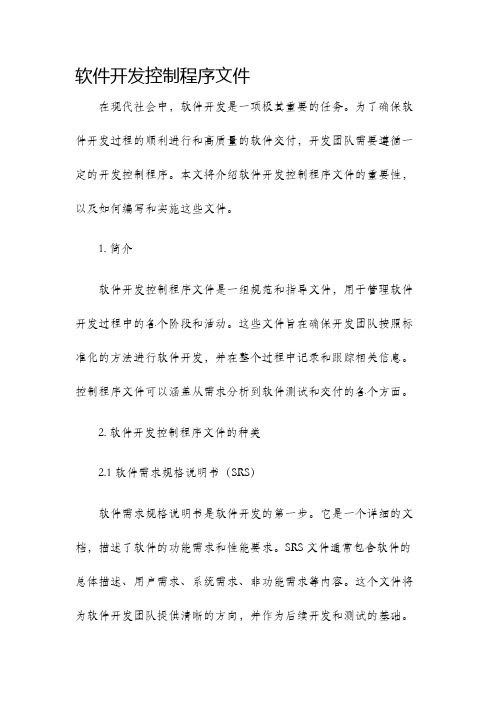
软件开发控制程序文件在现代社会中,软件开发是一项极其重要的任务。
为了确保软件开发过程的顺利进行和高质量的软件交付,开发团队需要遵循一定的开发控制程序。
本文将介绍软件开发控制程序文件的重要性,以及如何编写和实施这些文件。
1. 简介软件开发控制程序文件是一组规范和指导文件,用于管理软件开发过程中的各个阶段和活动。
这些文件旨在确保开发团队按照标准化的方法进行软件开发,并在整个过程中记录和跟踪相关信息。
控制程序文件可以涵盖从需求分析到软件测试和交付的各个方面。
2. 软件开发控制程序文件的种类2.1 软件需求规格说明书(SRS)软件需求规格说明书是软件开发的第一步。
它是一个详细的文档,描述了软件的功能需求和性能要求。
SRS文件通常包含软件的总体描述、用户需求、系统需求、非功能需求等内容。
这个文件将为软件开发团队提供清晰的方向,并作为后续开发和测试的基础。
2.2 软件设计文档(SDD)软件设计文档是软件开发过程中的关键文件。
它详细描述了软件的架构、模块、接口和数据结构。
SDD文件还包括关于算法、数据流、数据存储等的详细说明。
这个文件将帮助开发团队理解软件的设计并进行有效的编码和测试。
2.3 软件测试计划(STP)软件测试计划是确定软件测试策略和方法的文件。
在软件开发过程中,测试是确保软件质量的重要环节。
STP文件将详细描述测试的目标、范围、方法、环境和时间表。
这个文件将协助测试团队进行全面的测试,并提供关于软件质量的可靠数据。
2.4 软件配置管理计划(SCMP)软件配置管理计划是软件开发过程中的关键文件。
它规定了软件配置管理的过程和方法。
SCMP文件包括版本控制、配置审查、变更管理等内容,以确保软件的可控性和可维护性。
3. 编写软件开发控制程序文件的原则3.1 清晰和详细软件开发控制程序文件应该具有清晰和详细的描述。
它们应该明确规定每个步骤和活动的具体要求和标准。
这将帮助开发团队理解和遵循程序,并减少过程中的混乱和错误。
软件测试计划(STP)
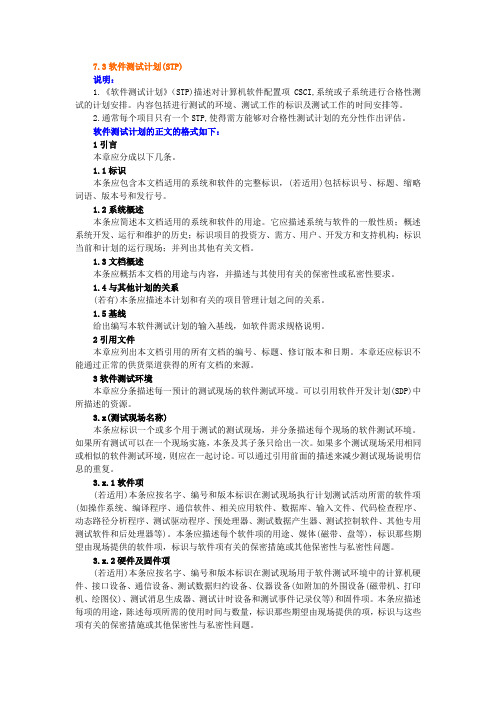
7.3软件测试计划(STP)说明:1.《软件测试计划》(STP)描述对计算机软件配置项CSCI,系统或子系统进行合格性测试的计划安排。
内容包括进行测试的环境、测试工作的标识及测试工作的时间安排等。
2.通常每个项目只有一个STP,使得需方能够对合格性测试计划的充分性作出评估。
软件测试计划的正文的格式如下:1引言本章应分成以下几条。
1.1标识本条应包含本文档适用的系统和软件的完整标识,(若适用)包括标识号、标题、缩略词语、版本号和发行号。
1.2系统概述本条应简述本文档适用的系统和软件的用途。
它应描述系统与软件的一般性质;概述系统开发、运行和维护的历史;标识项目的投资方、需方、用户、开发方和支持机构;标识当前和计划的运行现场;并列出其他有关文档。
1.3文档概述本条应概括本文档的用途与内容,并描述与其使用有关的保密性或私密性要求。
1.4与其他计划的关系(若有)本条应描述本计划和有关的项目管理计划之间的关系。
1.5基线给出编写本软件测试计划的输入基线,如软件需求规格说明。
2引用文件本章应列出本文档引用的所有文档的编号、标题、修订版本和日期。
本章还应标识不能通过正常的供货渠道获得的所有文档的来源。
3软件测试环境本章应分条描述每一预计的测试现场的软件测试环境。
可以引用软件开发计划(SDP)中所描述的资源。
3.x(测试现场名称)本条应标识一个或多个用于测试的测试现场,并分条描述每个现场的软件测试环境。
如果所有测试可以在一个现场实施,本条及其子条只给出一次。
如果多个测试现场采用相同或相似的软件测试环境,则应在一起讨论。
可以通过引用前面的描述来减少测试现场说明信息的重复。
3.x.1软件项(若适用)本条应按名字、编号和版本标识在测试现场执行计划测试活动所需的软件项(如操作系统、编译程序、通信软件、相关应用软件、数据库、输入文件、代码检查程序、动态路径分析程序、测试驱动程序、预处理器、测试数据产生器、测试控制软件、其他专用测试软件和后处理器等)。
软件测试报告模板
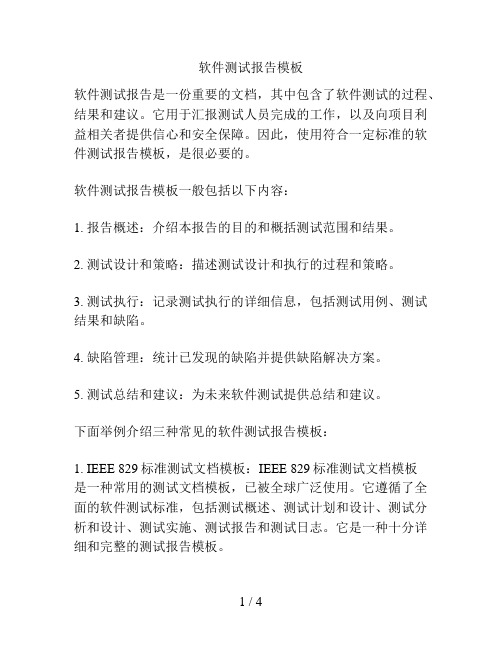
软件测试报告模板软件测试报告是一份重要的文档,其中包含了软件测试的过程、结果和建议。
它用于汇报测试人员完成的工作,以及向项目利益相关者提供信心和安全保障。
因此,使用符合一定标准的软件测试报告模板,是很必要的。
软件测试报告模板一般包括以下内容:1. 报告概述:介绍本报告的目的和概括测试范围和结果。
2. 测试设计和策略:描述测试设计和执行的过程和策略。
3. 测试执行:记录测试执行的详细信息,包括测试用例、测试结果和缺陷。
4. 缺陷管理:统计已发现的缺陷并提供缺陷解决方案。
5. 测试总结和建议:为未来软件测试提供总结和建议。
下面举例介绍三种常见的软件测试报告模板:1. IEEE 829标准测试文档模板:IEEE 829标准测试文档模板是一种常用的测试文档模板,已被全球广泛使用。
它遵循了全面的软件测试标准,包括测试概述、测试计划和设计、测试分析和设计、测试实施、测试报告和测试日志。
它是一种十分详细和完整的测试报告模板。
2. STP软件测试计划:Software Test Plan(STP)是一种很常见的测试文档模板,它包含架构、测试策略、测试进程和技术细节。
它详细描述了测试目标和计划,并解释了测试的范围、资源、时间表和质量控制标准。
它是非常清晰和简单的测试报告模板。
3. QA工作日报告:Quality Assurance(QA)日报告是每日汇报测试团队的日常工作进展的一种形式。
它包括每日的测试汇总、测试计划的变动、发现的缺陷、测试步骤等。
它非常适合日常交流和汇报使用。
以上是几种常见的软件测试报告模板,每种模板的适用场景和报告模板内容会有所不同。
根据实际需要选择相应的模板可以有效地提高质量,加强沟通和透明度,缩短项目周期,节省开发成本。
对于不同的项目和团队,选择适应的软件测试报告模板非常重要,它将帮助测试团队更好地组织测试过程,达到更高的测试效率,保证软件品质质量。
值得注意的是,虽然每个项目和团队都需要一个适合自己的测试报告模板,但一个好的测试报告模板应该能够提供信息的清晰简洁、直观明了、易于理解等特点,同时能够适应不同的测试流程和测试项目。
软件测试计划

编号:ST-XX-STP密级:2004年11月03日修改历史成的编号。
目录1概述本测试计划是针对PS平台的XX手机产品软件功能的测试工作而编写的,主要内容包括测试对象、测试步骤、接受标准、回归测试,同时也是测试组的测试任务、测试职责、人员安排、进度和测试的预期风险及使用BUG管理系统的描述,提供了一个对该软件系统的整体测试计划,用以指导本项目软件测试组的测试人员的工作,同时也为相关项目开发人员提供交流的依据。
XX具有内置摄像头、彩信、移动QQ等功能。
XX的单元测试、集成测试由开发组完成,测试组协同开发组进行测试。
系统测试由测试组完成,开发人员协同配合。
外部测试(现场测试,FTA/TA/SA)由项目软件经理负责,测试组配合。
1.1目标本测试计划的目标如下:检验手机软件系统是否满足XX软件需求规格说明书,XXUISpec,XX产品说明PD,XXMenuTree中的功能/性能的需求。
测试组的测试人员在项目启动后开始测试工作的准备,如编写软件系统测试计划,软件系统测试用例(包括手机软件的功能和性能,压力测试等方面),软件测试环境的搭建等。
其中根据XX软件需求规格说明定义的功能和性能需求,XXUISpec,XXMenuTree,XX产品特性说明PD编写XX软件系统测试用例。
在实际运行(使用)环境下根据评审通过的软件系统测试计划和软件系统测试用例进行软件系统的测试,并形成软件系统测试记录和测试Log。
依据软件系统测试记录和TestLog等相关信息,对测试记录的结果数据进行整理和评价,并形成软件系统测试报告(周报,里程碑报告,总结报告)。
外部测试(现场测试,FTA/TA/SA)的测试用例确保涵盖手机行业的标准或公司的标准。
1.2范围本文档适用于指导本项目软件测试组的测试工作。
其中内置摄像头、彩信、SMS、移动QQ、等为重点的测试模块。
1.3参考资料<><ST_QCT_XX_MENUTREE><ST_QCT_XX_SCMP><ST_QCT_XX_SQAP><ST_XX_UI_Spec><Objectiveofsoftwareimplementineveryphrase>术语及缩略词MMIManMachineinterfaceSMS ShortMessageServiceUIUserInterfaceFTA FinalTypeApproval,是各国GSM手机进入GSM网络必须通过的专业测试,国内开发的手机一般在邮电部传输所和7layers合资的公司参加测试TA即邮电部的移动终端入网测试,一般由各个品牌商出面参加测试SA ShipmentassessmentClearQuest:软件需求变更,软件缺陷跟踪管理工具ClearCase:软件版本配置管理工具TMT:TestManagementTool2测试对象下面为测试对象:1、消息(包括MMS、EMS、SMS)2、照相机3、移动QQ4、电话本5、我的文档6、设置7、附件8、STK9、WAP10、游戏11、电话拨打和接听12、输入法13、附加服务14、硬件相关15、其它3测试步骤1、项目启动后,项目软件测试负责人负责完成《XX软件系统测试计划》,并进行评审和更新维护。
计算机软件常见英文缩写及对应全称

1 CASE 计算机辅助软件工程(Computer Assistant Software Engineering)
2 COM 计算机操作手册(Computer Operation Manual)
3 CPM 计算机编程手册(Computer Programming Manual)
4 CSCI 计算机软件配置项(Computer Software Configuration Item)
5 DBDD 数据库(顶层)设计说明(Database Design Description)
6 DID 资料条目说明(Data Item Description)
7 DPMR 开发进度月报(Development Plan Month Report)
26 SQA 软件质量保证(Software Quality Assure)
27 SQAP 软件质量保证计划(Software Quality Assure Plan)
28 SRS 软件需求规格说明(Software Requirement SpeciSystem Subsystem Design Description)
22 SDL 软件开发库(Software Development Library)
23 SDP 软件开发计划(Software Development Plan)
24 SIP 软件安装计划(Software Installation Plan)
25 SPS 软件产品规格说明(Software Product Specification)
18 SCMP 软件配置管理计划(Software Configuration Manager Plan)
软件系统测试计划

文档类别:模板文档编号:TT-TEM-VAL/STP版本号: 1.0文档名称:软件系统测试计划项目名称:XXXXXX项目负责人:XXXXXX版本变更记录目录1简介 (4)1.1目的 (4)1.2项目背景 (4)1.3术语表 (4)1.4参考资料 (4)2任务概述 (4)2.1目标 (5)3用户需求概述 (6)3.1关键设计和实现技术说明 (6)3.2设计运行环境 (6)3.3条件与限制 (6)4测试方案 (7)4.1测试环境 (7)4.2测试需求 (7)4.2.1功能测试 (7)4.2.2性能测试 (8)4.2.3安装测试 (8)4.2.4环境兼容测试 (8)4.2.5恢复测试 (8)4.2.6安全性测试 (8)4.3系统预测试设计 (9)4.4测试用例 (9)4.5测试计划 (9)4.5.1测试人员 (9)4.5.2测试安排 (9)4.5.3测试准备工作 (10)4.5.4沟通渠道 (10)4.5.5风险评估 (10)5评价准则 (10)5.1范围 (11)5.2测试活动文档 (11)5.3准则 (11)1简介1.1目的【阐明写本测试计划的目的,并指明读者对象】【举例:本文档为完成《XXXX系统》的各个测试阶段测试所需测试活动提供计划。
本文档要提供给质量小组作为复查的依据,同时要反馈给开发小组。
】1.2项目背景1.3术语表【列出本测试计划中用到的专门术语的定义、缩写词的原意等等】【列出项目专业术语:如:开采现状图说明等等】系统预测试:这里特指测试组接到项目组集成测试后的软件,先对某个或某几个模块进行初步非正式测试,看看程序能否达到接受测试的条件,或者在接受测试时是否有故障。
主要是为了确保进行系统测试的版本足够稳定,可以拿来进一步测试。
它是一个相对简单的测试,这样可以避免测试资源的浪费。
1.4参考资料【如果需要参考该资料,但是项目组还没有提交,也可以暂时写在这里,在备注中填写未提交】2任务概述【这部分内容主要来自于开发过程中形成的各种文档,以及开发小组的解释说明】2.1目标【说明软件测试范围及要达到的目标,按主次排列】3用户需求概述【简单的用户需求情况说明。
软件测试计划(SCP)

软件测试计划(***产品)×××××有限公司发布文档修订记录软件测试计划(STP)说明:1.《软件测试计划》(STP)描述对计算机软件配置项CSCI,系统或子系统进行合格性测试的计划安排。
内容包括进行测试的环境、测试工作的标识及测试工作的时间安排等。
2.通常每个项目只有一个STP,使得需方能够对合格性测试计划的充分性作出评估。
目录软件测试计划(STP) (2)1 引言 (5)1.1 标识 (5)1.2 系统概述 (5)1.3 文档概述 (5)1.4 与其他计划的关系 (5)1.5 基线 (6)2 引用文件 (6)3 软件测试环境 (6)3.1 3.x(测试现场名称) (6)3.1.1 3.x.1软件项 (6)3.1.2 3.x.2硬件及固件项 (7)3.1.3 3.x.3其他材料 (7)3.1.4 3.x.4所有权种类、需方权利与许可证 ...........................错误!未定义书签。
3.1.5 3.x.5安装、测试与控制 (7)3.1.6 3.x.6参与组织 (7)3.1.7 3.x.7人员 (7)3.1.8 3.x.8定向计划 (8)3.1.9 3.x.9要执行的测试 ...........................................................错误!未定义书签。
4 计划 (8)4.1 总体设计 (8)4.1.1测试级 (8)4.1.2测试类别 (8)4.1.3一般测试条件...........................................................................错误!未定义书签。
4.1.4测试过程 (8)4.1.5数据记录、归约和分析 (8)4.2 计划执行的测试 (9)4.2.x(被测试项) (9)4.3 测试用例 (9)5 测试进度表 (10)6 风险 (10)7 需求的可追踪性 (10)8 注解 (11)附录 (11)1引言1.1标识本条应包含本文档适用的系统(软件)的完整且唯一的标识,包括软件型号,版本号及命名规则,(若适用)缩略词语。
软件测试计划(STP)文档标准模版

软件测试计划(STP)XXXX公司文件更改记录文件版本变更记录软件测试计划(STP)说明:1.《软件测试计划》(STP)描述对计算机软件配置项CSCI,系统或子系统进行合格性测试的计划安排。
内容包括进行测试的环境、测试工作的标识及测试工作的时间安排等。
2.通常每个项目只有一个STP,使得需方能够对合格性测试计划的充分性作出评估。
模版说明:1、文档字体设定:标题1:小一标题2:二号标题3:小二标题4:三号标题5:小三标题6:四号正文:四号2、文章编号,请使用格式刷刷,不要手工编号。
目前格式都是对的。
3、内容根据实际情况裁剪,一般可行性研究报告,模版章节不可缺。
4、封面图片请根据实际情况自行替换。
5、关于修订记录,请根据文档需要自行添加。
1.引言本章分为以下几条。
1.1.标识本条应包含本文档适用的系统和软件的完整标识,(若适用)包括标识号、标题、缩略词语、版本号和发行号。
1.2.系统概述本条应简述本文档适用的系统和软件的用途。
它应描述系统与软件的一般性质;概述系统开发、运行和维护的历史;标识项目的投资方、需方、用户、开发方和支持机构;标识当前和计划的运行现场;并列出其他有关文档。
1.3.文档概述本条应概括本文档的用途与内容,并描述与其使用有关的保密性或私密性要求。
1.4.与其他计划的关系(若有)本条应描述本计划和有关的项目管理计划之间的关系。
1.5.基线给出编写本软件测试计划的输入基线,如软件需求规格说明。
2.引用文件本章应列出本文档引用的所有文档的编号、标题、修订版本和日期。
本章还应标识不能通过正常的供货渠道获得的所有文档的来源。
3.软件测试环境本章应分条描述每一预计的测试现场的软件测试环境。
可以引用软件开发计划(SDP)中所描述的资源。
3.1.3.x(测试现场名称)本条应标识一个或多个用于测试的测试现场,并分条描述每个现场的软件测试环境。
如果所有测试可以在一个现场实施,本条及其子条只给出一次。
如果多个测试现场采用相同或相似的软件测试环境,则应在一起讨论。
gjb438b软件测试计划
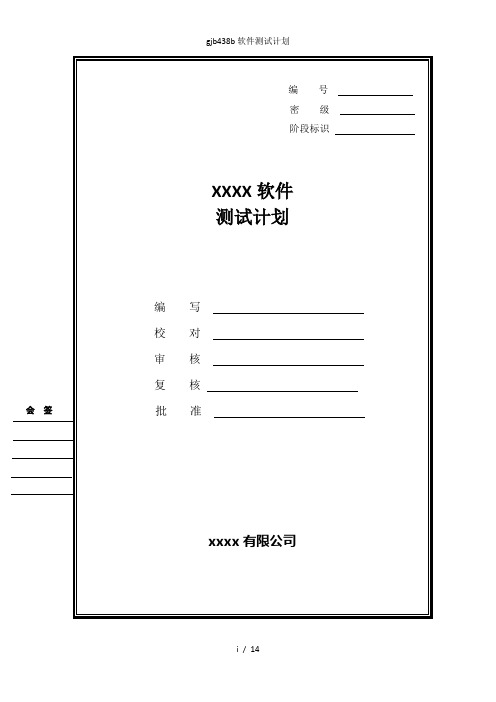
修订记录目录1范围1.1标识本文档标识号:xxx/STP本文档名称:xxxx测试计划缩略名:版本号:发布号:1.2系统概述本条应概述本文档所适用的系统和软件的用途;1.3文档概述本文档对xxxxx系统中的配置项IF2综合信息显示软件详细介绍,并对软件提出了具体测试要求。
本文档编写的目的:1)xxx系统软件测试的依据。
2)xxxx软件交付依据。
1.4与其他计划的关系本文档………………软件测试计划。
2引用文档引用文档见表2-1。
表2-1 测试软件项3测试依据本项目的测试依据见表3-1。
4软件测试环境4.1软件项测试的软件项见表4-1。
4.2硬件和固件项系统测试需要的硬件和固件项由高性能数据库服务器、图形工作站、情报数据管理维护计算机以及磁盘阵列组成。
这些硬件配置项通过内部局域网络连接,为IF2系统软件运行提供了硬件支持环境。
如表4-2所示。
4.3其他项系统中需要的硬件结构网络拓扑图见图4-1。
4.4其他材料对本系统进行测试,在测试现场执行测试所需的其他材料参见表表4-1 其他材料表4.5所有者的特性、需方权利和许可证无许可证。
4.6安装、测试与控制4.7测试环境的差异性分析和有效性说明无。
4.8参与组织本系统的参与组织包括总体部门、研发部门、测试部门和质量管理部门人员共同完成。
4.9人员及分工测试人员及分工参见表4-6。
表4-2 测试人员安排表4.10人员培训使用单位首次装备产品时,由生产处负责组织各分系统相关人员向使用单位介绍产品的基本性能与结构特点,并进行使用维护及操作性培训。
4.11要执行的测试5测试标识5.1一般信息5.1.1测试级本系统执行测试的级别为系统级局或者CSCI级别。
5.1.2测试类别针对本系统需要执行的测试类别包括功能测试、性能测试、接口测试和流程测试。
5.1.3一般测试条件对软件进行正式合格性测试一般测试条件应满足以下要求:1)应提供各功能项的测试数据源,对系统进行全面、完整的覆盖性测试。
软件开发中常见的一些缩写及含意

(一)软件开发中常见的一些缩写及含意AAI Action Item活动项 CCA Comprehensive Audit综合检查CCB Configuration Control Board配置控制部CDR Critical Design Review关键设计评审CD&UT Coding and Unit Testing phase编码与单元测试阶段CMM Capability Maturity Model成熟度模型CRLCMP Computer Resource Life Cycle Management Plan计算机资源生命周期管理计划CSCI Computer Software Configuration Item计算机软件配置项critical software 重要软件DDBDD Data Base Design Description数据库设计描述DCR Document Change Request文档更改请求DD Detailed Design Phase详细设计阶段DDD Detailed Design Document详细设计文档DDR Detailed Design Review详细设计评审DID Data Item Description数据项描述design level 设计层FFCA Functional Configuration Audit功能配置审查FA Functional Audit功能检查FI Formal Inspection正式检查FQR Formal Qualification Review正式鉴定评审HHB HandBook手册HWCI HardWare Configuration Item硬件配置项IIDD Interface Design Description接口设计描述IRS Interface Requirements Specification接口需求规格说明IT&ST Integrating and System Testing phase组装与系统测试阶段IS&AC Installation and Acceptance phase安装与验收阶段IV&V Independent Verification and Validation 独立验证与确认KKPA Key Process Area关键过程域Mmanagement reviews 管理评审NNDS Non-Developmental Software不可开发软件PPA Physical Audit物理检查PCA Physical Configuration Audit物理配置审查PD Preliminary Design Phase概要设计阶段PDD Preliminary Design Document概要设计文档PDR Preliminary Design Review初步设计评审(概要设计评审)PDS 项目开发总结PIP 项目实施计划PRR 阶段评审报表PRR Product Readiness Review产品准备就绪评审PP&O Project Planning and Oversight项目计划与监督PPP 项目进展报表Pass criteria 通过准则project entrust organization 项目委托单位project undertaking organization 项目承办单位Qquality assurance 质量保证QC QUALITY CONTROL 品质控制RRA Requirements Analysis Phase需求分析阶段RMT 评审成员签字表RPL Review Problem评审问题记RSR Review Summary Report评审总结报告SSA&SD System Analysis and software definition phase系统分析与软件定义阶段SCL 源程序清单SCM Software Configuration Management软件配置管理SCMP Software Configuration Management Plan软件配置管理计划SDD Software Design Document软件设计文档(分成概要设计说明书[PDD]和详细设计说明书[DDD])SDF Software Development File软件开发文件SDL Software Development Library软件开发库SDP Software Development Plan软件开发计划SDR System Design Review系统设计评审SEI Software Engineering Institute软件工程学会SEPO Software Engineering Process Office软件工程过程办公室SOW Statement of Work工作说明SPR Software Problem Report软件问题报告单SQA Software Quality Assurance软件质量保证SQAP Software Quality Assurance Plan软件质量保证计划SRR 软件需求评审SRR System Requirements Review系统需求评审SRS Software Requirment Specification软件需求规格说明SSDD System/Subsystem Design Description系统/子系统设计描述SSR Software Specification Review软件规格说明评审SSS System/Subsystem Specification系统/子系统规格说明STP 软件测试计划STR 软件测试报告STR Software Trouble Report软件故障报告STSC Software Technoligy Support Center软件技术支持中心SUM 用户手册SVD Software Version Description软件版本描述SV&VP Software Verification and Validation Plan软件验证与确认计划SV&VR Software Verification and Validation Review软件验证与确认评审SW-CMM SoftWare Capability Maturity Model软件成熟度模型software 软件software development organization 软件开发单位software feature 软件特性software item 软件项software life cycle 软件生存周期software verification and validation report软件验证与确认报告TTR Technical Report技术报告TRR Test Readiness Review测试准备就绪评审TSSD Total Software System Development phase整个软件系统的开发阶段testing 测试test item 测试项UUDF Unit Development Folder单元开发文件夹user 用户user documentation 用户文档UT Unit Test 单元测试Vvalidation 确认verification 验证WWBS Work Breakdown Structure工作分解结构。
软件测试英语术语+缩写

软件测试常用英语词汇静态测试:Non-Execution-Based Testing或Static testing 代码走查:Walkthrough代码审查:Code Inspection技术评审:Review动态测试:Execution-Based Testing白盒测试:White-Box Testing黑盒测试:Black-Box Testing灰盒测试:Gray-Box Testing软件质量保证SQA:Software Quality Assurance软件开发生命周期:Software Development Life Cycle冒烟测试:Smoke Test回归测试:Regression Test功能测试:Function Testing性能测试:Performance Testing压力测试:Stress Testing负载测试:Volume Testing易用性测试:Usability Testing安装测试:Installation Testing界面测试:UI Testing配置测试:Configuration Testing文档测试:Documentation Testing兼容性测试:Compatibility Testing安全性测试:Security Testing恢复测试:Recovery Testing单元测试:Unit Test集成测试:Integration Test系统测试:System Test验收测试:Acceptance Test测试计划应包括:测试对象:The Test Objectives测试范围: The Test Scope测试策略: The Test Strategy测试方法: The Test Approach,测试过程: The test procedures,测试环境: The Test Environment,测试完成标准:The test Completion criteria测试用例:The Test Cases测试进度表:The Test Schedules风险:Risks接口:Interface最终用户:The End User正式的测试环境:Formal Test Environment确认需求:Verifying The Requirements有分歧的需求:Ambiguous Requirements运行和维护:Operation and Maintenance.可复用性:Reusability可靠性: Reliability/Availability电机电子工程师协会IEEE:The Institute of Electrical and Electronics Engineers) 正确性:Correctness实用性:Utility健壮性:Robustness可靠性:Reliability软件需求规格说明书:SRS (software requirement specification )概要设计:HLD (high level design )详细设计:LLD (low level design )统一开发流程:RUP (rational unified process )集成产品开发:IPD (integrated product development )能力成熟模型:CMM (capability maturity model )能力成熟模型集成:CMMI (capability maturity model integration )戴明环:PDCA (plan do check act )软件工程过程组:SEPG (software engineering process group )集成测试:IT (integration testing )系统测试:ST (system testing )关键过程域:KPA (key process area )同行评审:PR (peer review )用户验收测试:UAT (user acceptance testing )验证和确认:V&V (verification & validation )控制变更委员会:CCB (change control board )图形用户界面:GUI (graphic user interface )配置管理员:CMO (configuration management officer )平均失效间隔时间:(MTBF mean time between failures )平均修复时间:MTTR (mean time to restoration )平均失效时间:MTTF (mean time to failure )工作任务书:SOW (statement of work )α测试:alpha testingβ测试:beta testing适应性:Adaptability可用性:Availability功能规格说明书:Functional Specification软件开发中常见英文缩写和各类软件开发文档的英文缩写:英文简写文档名称MRD market requirement document (市场需求文档)PRD product requirement document (产品需求文档)SOW 工作任务说明书PHB Process Handbook (项目过程手册)EST Estimation Sheet (估计记录)PPL Project Plan (项目计划)CMP Software Management Plan( 配置管理计划)QAP Software Quality Assurance Plan (软件质量保证计划)RMP Software Risk Management Plan (软件风险管理计划)TST Test Strategy(测试策略)WBS Work Breakdown Structure (工作分解结构)BRS Business Requirement Specification(业务需求说明书)SRS Software Requirement Specification(软件需求说明书)STP System Testing plan (系统测试计划)STC System Testing Cases (系统测试用例)HLD High Level Design (概要设计说明书)ITP Integration Testing plan (集成测试计划)ITC Integration Testing Cases (集成测试用例)LLD Low Level Design (详细设计说明书)UTP Unit Testing Plan ( 单元测试计划)UTC Unit Testing Cases (单元测试用例)UTR Unit Testing Report (单元测试报告)ITR Integration Testing Report (集成测试报告)STR System Testing Report (系统测试报告)RTM Requirements Traceability Matrix (需求跟踪矩阵)CSA Configuration Status Accounting (配置状态发布)CRF Change Request Form (变更申请表)WSR Weekly Status Report (项目周报)QSR Quality Weekly Status Report (质量工作周报)QAR Quality Audit Report(质量检查报告)QCL Quality Check List(质量检查表)PAR Phase Assessment Report (阶段评估报告)CLR Closure Report (项目总结报告)RFF Review Finding Form (评审发现表)MOM Minutes of Meeting (会议纪要)MTX Metrics Sheet (度量表)CCF ConsistanceCheckForm(一致性检查表)BAF Baseline Audit Form(基线审计表)PTF Program Trace Form(问题跟踪表)领测国际科技(北京)有限公司领测软件测试网 /软件测试中英文对照术语表A• Abstract test case (High level test case) :概要测试用例• Acceptance:验收• Acceptance criteria:验收标准• Acceptance testing:验收测试• Accessibility testing:易用性测试• Accuracy:精确性• Actual outcome (actual result) :实际输出/实际结果• Ad hoc review (informal review) :非正式评审• Ad hoc testing:随机测试• Adaptability:自适应性• Agile testing:敏捷测试• Algorithm test (branch testing) :分支测试• Alpha testing:alpha 测试• Analyzability:易分析性• Analyzer:分析员• Anomaly:异常• Arc testing:分支测试• Attractiveness:吸引力• Audit:审计• Audit trail:审计跟踪• Automated testware:自动测试组件• Availability:可用性B• Back-to-back testing:对比测试• Baseline:基线• Basic block:基本块• Basis test set:基本测试集• Bebugging:错误撒播• Behavior:行为• Benchmark test:基准测试• Bespoke software:定制的软件• Best practice:最佳实践• Beta testing:Beta 测试领测国际科技(北京)有限公司领测软件测试网 /• Big-bang testing:集成测试• Black-box technique:黑盒技术• Black-box testing:黑盒测试• Black-box test design technique:黑盒测试设计技术• Blocked test case:被阻塞的测试用例• Bottom-up testing:自底向上测试• Boundary value:边界值• Boundary value analysis:边界值分析• Boundary value coverage:边界值覆盖率• Boundary value testing:边界值测试• Branch:分支• Branch condition:分支条件• Branch condition combination coverage:分支条件组合覆盖率• Branch condition combination testing:分支条件组合测试• Branch condition coverage:分支条件覆盖率• Branch coverage:分支覆盖率• Branch testing:分支测试• Bug:缺陷• Business process-based testing:基于商业流程的测试C• Capability Maturity Model (CMM) :能力成熟度模型• Capability Maturity Model Integration (CMMI) :集成能力成熟度模型• Capture/playback tool:捕获/回放工具• Capture/replay tool:捕获/重放工具• CASE (Computer Aided Software Engineering) :电脑辅助软件工程• CAST (Computer Aided Software Testing) :电脑辅助软件测试• Cause-effect graph:因果图• Cause-effect graphing:因果图技术• Cause-effect analysis:因果分析• Cause-effect decision table:因果判定表• Certification:认证• Changeability:可变性• Change control:变更控制• Change control board:变更控制委员会• Checker:检查人员• Chow's coverage metrics (N-switch coverage) :N 切换覆盖率• Classification tree method:分类树方法• Code analyzer:代码分析器• Code coverage:代码覆盖率领测国际科技(北京)有限公司领测软件测试网 /• Code-based testing:基于代码的测试• Co-existence:共存性• Commercial off-the-shelf software:商用离岸软件• Comparator:比较器• Compatibility testing:兼容性测试• Compiler:编译器• Complete testing:完全测试/穷尽测试• Completion criteria:完成标准• Complexity:复杂性• Compliance:一致性• Compliance testing:一致性测试• Component:组件• Component integration testing:组件集成测试• Component specification:组件规格说明• Component testing:组件测试• Compound condition:组合条件• Concrete test case (low level test case) :详细测试用例• Concurrency testing:并发测试• Condition:条件表达式• Condition combination coverage:条件组合覆盖率• Condition coverage:条件覆盖率• Condition determination coverage:条件判定覆盖率• Condition determination testing:条件判定测试• Condition testing:条件测试• Condition outcome:条件结果• Confidence test (smoke test) :信心测试(冒烟测试)• Configuration:配置• Configuration auditing:配置审核• Configuration control:配置控制• Configuration control board (CCB) :配置控制委员会• Configuration identification:配置标识• Configuration item:配置项• Configuration management:配置管理• Configuration testing:配置测试• Confirmation testing:确认测试• Conformance testing:一致性测试• Consistency:一致性• Control flow:控制流• Control flow graph:控制流图• Control flow path:控制流路径• Conversion testing:转换测试• COTS (Commercial Off-The-Shelf software) :商业离岸软件• Coverage:覆盖率• Coverage analysis:覆盖率分析领测国际科技(北京)有限公司领测软件测试网 /• Coverage item:覆盖项• Coverage tool:覆盖率工具• Custom software:定制软件• Cyclomatic complexity:圈复杂度• Cyclomatic number:圈数D• Daily build:每日构建• Data definition:数据定义• Data driven testing:数据驱动测试• Data flow:数据流• Data flow analysis:数据流分析• Data flow coverage:数据流覆盖率• Data flow test:数据流测试• Data integrity testing:数据完整性测试• Database integrity testing:数据库完整性测试• Dead code:无效代码• Debugger:调试器• Debugging:调试• Debugging tool:调试工具• Decision:判定• Decision condition coverage:判定条件覆盖率• Decision condition testing:判定条件测试• Decision coverage:判定覆盖率• Decision table:判定表• Decision table testing:判定表测试• Decision testing:判定测试技术• Decision outcome:判定结果• Defect:缺陷• Defect density:缺陷密度• Defect Detection Percentage (DDP) :缺陷发现率• Defect management:缺陷管理• Defect management tool:缺陷管理工具• Defect masking:缺陷屏蔽• Defect report:缺陷报告• Defect tracking tool:缺陷跟踪工具• Definition-use pair:定义-使用对• Deliverable:交付物• Design-based testing:基于设计的测试• Desk checking:桌面检查领测国际科技(北京)有限公司领测软件测试网 /• Development testing:开发测试• Deviation:偏差• Deviation report:偏差报告• Dirty testing:负面测试• Documentation testing:文档测试• Domain:域• Driver:驱动程序• Dynamic analysis:动态分析• Dynamic analysis tool:动态分析工具• Dynamic comparison:动态比较• Dynamic testing:动态测试E• Efficiency:效率• Efficiency testing:效率测试• Elementary comparison testing:基本组合测试• Emulator:仿真器、仿真程序• Entry criteria:入口标准• Entry point:入口点• Equivalence class:等价类• Equivalence partition:等价区间• Equivalence partition coverage:等价区间覆盖率• Equivalence partitioning:等价划分技术• Error:错误• Error guessing:错误猜测技术• Error seeding:错误撒播• Error tolerance:错误容限• Evaluation:评估• Exception handling:异常处理• Executable statement:可执行的语句• Exercised:可执行的• Exhaustive testing:穷尽测试• Exit criteria:出口标准• Exit point:出口点• Expected outcome:预期结果• Expected result:预期结果• Exploratory testing:探测测试领测国际科技(北京)有限公司领测软件测试网 /F• Fail:失败• Failure:失败• Failure mode:失败模式• Failure Mode and Effect Analysis (FMEA) :失败模式和影响分析• Failure rate:失败频率• Fault:缺陷• Fault density:缺陷密度• Fault Detection Percentage (FDP) :缺陷发现率• Fault masking:缺陷屏蔽• Fault tolerance:缺陷容限• Fault tree analysis:缺陷树分析• Feature:特征• Field testing:现场测试• Finite state machine:有限状态机• Finite state testing:有限状态测试• Formal review:正式评审• Frozen test basis:测试基线• Function Point Analysis (FPA) :功能点分析• Functional integration:功能集成• Functional requirement:功能需求• Functional test design technique:功能测试设计技术• Functional testing:功能测试• Functionality:功能性• Functionality testing:功能性测试G• glass box testing:白盒测试H• Heuristic evaluation:启发式评估• High level test case:概要测试用例• Horizontal traceability:水平跟踪领测国际科技(北京)有限公司领测软件测试网 /I• Impact analysis:影响分析• Incremental development model:增量开发模型• Incremental testing:增量测试• Incident:事件• Incident management:事件管理• Incident management tool:事件管理工具• Incident report:事件报告• Independence:独立• Infeasible path:不可行路径• Informal review:非正式评审• Input:输入• Input domain:输入范围• Input value:输入值• Inspection:审查• Inspection leader:审查组织者• Inspector:审查人员• Installability:可安装性• Installability testing:可安装性测试• Installation guide:安装指南• Installation wizard:安装向导• Instrumentation:插装• Instrumenter:插装工具• Intake test:入口测试• Integration:集成• Integration testing:集成测试• Integration testing in the large:大范围集成测试• Integration testing in the small:小范围集成测试• Interface testing:接口测试• Interoperability:互通性• Interoperability testing:互通性测试• Invalid testing:无效性测试• Isolation testing:隔离测试• Item transmittal report:版本发布报告• Iterative development model:迭代开发模型K• Key performance indicator:关键绩效指标领测国际科技(北京)有限公司领测软件测试网 /• Keyword driven testing:关键字驱动测试L• Learnability:易学性• Level test plan:等级测试计划• Link testing:组件集成测试• Load testing:负载测试• Logic-coverage testing:逻辑覆盖测试• Logic-driven testing:逻辑驱动测试• Logical test case:逻辑测试用例• Low level test case:详细测试用例M• Maintenance:维护• Maintenance testing:维护测试• Maintainability:可维护性• Maintainability testing:可维护性测试• Management review:管理评审• Master test plan:综合测试计划• Maturity:成熟度• Measure:度量• Measurement:度量• Measurement scale:度量粒度• Memory leak:内存泄漏• Metric:度量• Migration testing:移植测试• Milestone:里程碑• Mistake:错误• Moderator:仲裁员• Modified condition decision coverage:改进的条件判定覆盖率• Modified condition decision testing:改进的条件判定测试• Modified multiple condition coverage:改进的多重条件判定覆盖率• Modified multiple condition testing:改进的多重条件判定测试• Module:模块• Module testing:模块测试• Monitor:监视器• Multiple condition:多重条件• Multiple condition coverage:多重条件覆盖率领测国际科技(北京)有限公司领测软件测试网 /• Multiple condition testing:多重条件测试• Mutation analysis:变化分析• Mutation testing:变化测试N• N-switch coverage:N 切换覆盖率• N-switch testing:N 切换测试• Negative testing:负面测试• Non-conformity:不一致• Non-functional requirement:非功能需求• Non-functional testing:非功能测试• Non-functional test design techniques:非功能测试设计技术O• Off-the-shelf software:离岸软件• Operability:可操作性• Operational environment:操作环境• Operational profile testing:运行剖面测试• Operational testing:操作测试• Oracle:标准• Outcome:输出/结果• Output:输出• Output domain:输出范围• Output value:输出值P• Pair programming:结队编程• Pair testing:结队测试• Partition testing:分割测试• Pass:通过• Pass/fail criteria:通过/失败标准• Path:路径• Path coverage:路径覆盖• Path sensitizing:路径敏感性• Path testing:路径测试领测国际科技(北京)有限公司领测软件测试网 / • Peer review:同行评审• Performance:性能• Performance indicator:绩效指标• Performance testing:性能测试• Performance testing tool:性能测试工具• Phase test plan:阶段测试计划• Portability:可移植性• Portability testing:移植性测试• Postcondition:结果条件• Post-execution comparison:运行后比较• Precondition:初始条件• Predicted outcome:预期结果• Pretest:预测试• Priority:优先级• Probe effect:检测成本• Problem:问题• Problem management:问题管理• Problem report:问题报告• Process:流程• Process cycle test:处理周期测试• Product risk:产品风险• Project:项目• Project risk:项目风险• Program instrumenter:编程工具• Program testing:程序测试• Project test plan:项目测试计划• Pseudo-random:伪随机Q• Quality:质量• Quality assurance:质量保证• Quality attribute:质量属性• Quality characteristic:质量特征• Quality management:质量管理领测国际科技(北京)有限公司领测软件测试网 /R• Random testing:随机测试• Recorder:记录员• Record/playback tool:记录/回放工具• Recoverability:可复原性• Recoverability testing:可复原性测试• Recovery testing:可复原性测试• Regression testing:回归测试• Regulation testing:一致性测试• Release note:版本说明• Reliability:可靠性• Reliability testing:可靠性测试• Replaceability:可替换性• Requirement:需求• Requirements-based testing:基于需求的测试• Requirements management tool:需求管理工具• Requirements phase:需求阶段• Resource utilization:资源利用• Resource utilization testing:资源利用测试• Result:结果• Resumption criteria:继续测试标准• Re-testing:再测试• Review:评审• Reviewer:评审人员• Review tool:评审工具• Risk:风险• Risk analysis:风险分析• Risk-based testing:基于风险的测试• Risk control:风险控制• Risk identification:风险识别• Risk management:风险管理• Risk mitigation:风险消减• Robustness:健壮性• Robustness testing:健壮性测试• Root cause:根本原因S• Safety:安全领测国际科技(北京)有限公司领测软件测试网 /• Safety testing:安全性测试• Sanity test:健全测试• Scalability:可测量性• Scalability testing:可测量性测试• Scenario testing:情景测试• Scribe:记录员• Scripting language:脚本语言• Security:安全性• Security testing:安全性测试• Serviceability testing:可维护性测试• Severity:严重性• Simulation:仿真• Simulator:仿真程序、仿真器• Site acceptance testing:定点验收测试• Smoke test:冒烟测试• Software:软件• Software feature:软件功能• Software quality:软件质量• Software quality characteristic:软件质量特征• Software test incident:软件测试事件• Software test incident report:软件测试事件报告• Software Usability Measurement Inventory (SUMI) :软件可用性调查问卷• Source statement:源语句• Specification:规格说明• Specification-based testing:基于规格说明的测试• Specification-based test design technique:基于规格说明的测试设计技术• Specified input:特定输入• Stability:稳定性• Standard software:标准软件• Standards testing:标准测试• State diagram:状态图• State table:状态表• State transition:状态迁移• State transition testing:状态迁移测试• Statement:语句• Statement coverage:语句覆盖• Statement testing:语句测试• Static analysis:静态分析• Static analysis tool:静态分析工具• Static analyzer:静态分析工具• Static code analysis:静态代码分析• Static code analyzer:静态代码分析工具• Static testing:静态测试• Statistical testing:统计测试领测国际科技(北京)有限公司领测软件测试网 /• Status accounting:状态统计• Storage:资源利用• Storage testing:资源利用测试• Stress testing:压力测试• Structure-based techniques:基于结构的技术• Structural coverage:结构覆盖• Structural test design technique:结构测试设计技术• Structural testing:基于结构的测试• Structured walkthrough:面向结构的走查• Stub: 桩• Subpath: 子路径• Suitability: 符合性• Suspension criteria: 暂停标准• Syntax testing: 语法测试• System:系统• System integration testing:系统集成测试• System testing:系统测试T• Technical review:技术评审• Test:测试• Test approach:测试方法• Test automation:测试自动化• Test basis:测试基础• Test bed:测试环境• Test case:测试用例• Test case design technique:测试用例设计技术• Test case specification:测试用例规格说明• Test case suite:测试用例套• Test charter:测试宪章• Test closure:测试结束• Test comparator:测试比较工具• Test comparison:测试比较• Test completion criteria:测试比较标准• Test condition:测试条件• Test control:测试控制• Test coverage:测试覆盖率• Test cycle:测试周期• Test data:测试数据• Test data preparation tool:测试数据准备工具领测国际科技(北京)有限公司领测软件测试网 / • Test design:测试设计• Test design specification:测试设计规格说明• Test design technique:测试设计技术• Test design tool: 测试设计工具• Test driver: 测试驱动程序• Test driven development: 测试驱动开发• Test environment: 测试环境• Test evaluation report: 测试评估报告• Test execution: 测试执行• Test execution automation: 测试执行自动化• Test execution phase: 测试执行阶段• Test execution schedule: 测试执行进度表• Test execution technique: 测试执行技术• Test execution tool: 测试执行工具• Test fail: 测试失败• Test generator: 测试生成工具• Test leader:测试负责人• Test harness:测试组件• Test incident:测试事件• Test incident report:测试事件报告• Test infrastructure:测试基础组织• Test input:测试输入• Test item:测试项• Test item transmittal report:测试项移交报告• Test level:测试等级• Test log:测试日志• Test logging:测试记录• Test manager:测试经理• Test management:测试管理• Test management tool:测试管理工具• Test Maturity Model (TMM) :测试成熟度模型• Test monitoring:测试跟踪• Test object:测试对象• Test objective:测试目的• Test oracle:测试标准• Test outcome:测试结果• Test pass:测试通过• Test performance indicator:测试绩效指标• Test phase:测试阶段• Test plan:测试计划• Test planning:测试计划• Test policy:测试方针• Test Point Analysis (TPA) :测试点分析• Test procedure:测试过程领测国际科技(北京)有限公司领测软件测试网 /• Test procedure specification:测试过程规格说明• Test process:测试流程• Test Process Improvement (TPI) :测试流程改进• Test record:测试记录• Test recording:测试记录• Test reproduceability:测试可重现性• Test report:测试报告• Test requirement:测试需求• Test run:测试运行• Test run log:测试运行日志• Test result:测试结果• Test scenario:测试场景• Test script:测试脚本• Test set:测试集• Test situation:测试条件• Test specification:测试规格说明• Test specification technique:测试规格说明技术• Test stage:测试阶段• Test strategy:测试策略• Test suite:测试套• Test summary report:测试总结报告• Test target:测试目标• Test tool:测试工具• Test type:测试类型• Testability:可测试性• Testability review:可测试性评审• Testable requirements:需求可测试性• Tester:测试人员• Testing:测试• Testware:测试组件• Thread testing:组件集成测试• Time behavior:性能• Top-down testing:自顶向下的测试• Traceability:可跟踪性U• Understandability:易懂性• Unit:单元• unit testing:单元测试• Unreachable code:执行不到的代码领测国际科技(北京)有限公司领测软件测试网 /• Usability:易用性• Usability testing:易用性测试• Use case:用户用例• Use case testing:用户用例测试• User acceptance testing:用户验收测试• User scenario testing:用户场景测试• User test:用户测试V• V -model:V 模式• Validation:确认• Variable:变量• Verification:验证• Vertical traceability:垂直可跟踪性• Version control:版本控制• Volume testing:容量测试W• Walkthrough:走查• White-box test design technique:白盒测试设计技术• White-box testing:白盒测试• Wide Band Delphi:Delphi 估计方法。
3软件测试计划(STP)
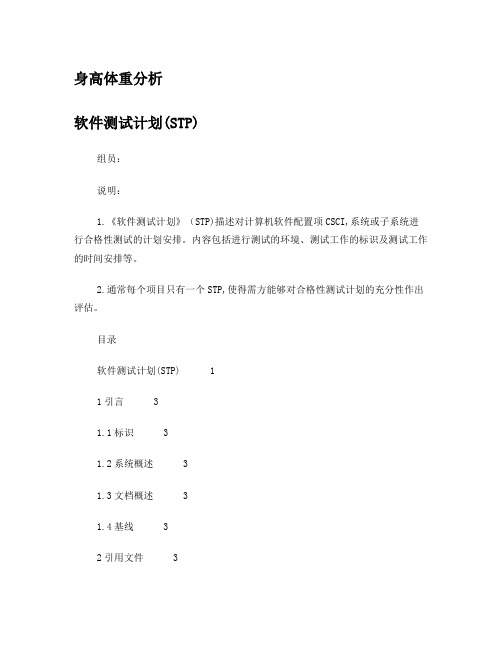
身高体重分析软件测试计划(STP)组员:说明:1.《软件测试计划》(STP)描述对计算机软件配置项CSCI,系统或子系统进行合格性测试的计划安排。
内容包括进行测试的环境、测试工作的标识及测试工作的时间安排等。
2.通常每个项目只有一个STP,使得需方能够对合格性测试计划的充分性作出评估。
目录软件测试计划(STP) 11引言 31.1标识 31.2系统概述 31.3文档概述 31.4基线 32引用文件 33软件测试环境 43.1软件测试环境 43.2硬件测试环境 43.3其他材料 43.4安装、测试与控制 43. 5参与组织 43.6人员 43.7定向计划 43.8要执行的测试 44计划 54.1总体设计 54.1.1测试级 54.1.2测试类别 54.1.3一般测试条件 54.1.4测试过程 54.1.5数据记录、归约和分析 6 4.2计划执行的测试 64.2.1测试名称及内容 64.3测试用例 85测试进度表 76评价 76.1评价准则 76.2数据处理 76.3结论 77注解 8附录 81引言1.1标识身高体重分析软件Windows 7版本号:1.01.2系统概述一套针对身高体重测试的分析软件,所有人都能使用,它包括了检测体型是否正常,个人身高所对应的标准体重,预测未来身高以及最合适的伴侣体型。
需求方:健身中心,减肥中心等开发者:计算机团队小组用户:所有人均可使用原有系统只能依靠输入身高体重来测试自己体型是否正常。
现有系统可以通过测试身高体型比例来提出合理的饮食建议,此外还实现了许多额外功能来使软件功能更加丰富,更受使用者青睐。
1.3文档概述该文档描述对软件系统进行合格性测试的计划安排。
内容包括进行测试的环境、测试工作的标识及测试工作的时间安排等。
本文档的阅读对象如下:1、开发人员2、测试阶段人员3、对本文档进行评审的人员或机构4、项目组及其他有权需要调用本文档的人员1.4基线本项目软件测试计划的输入基线为软件需求规格说明、概要设计说明书和详细设计说明书。
软件开发文档论文4200字_软件开发文档毕业论文范文模板
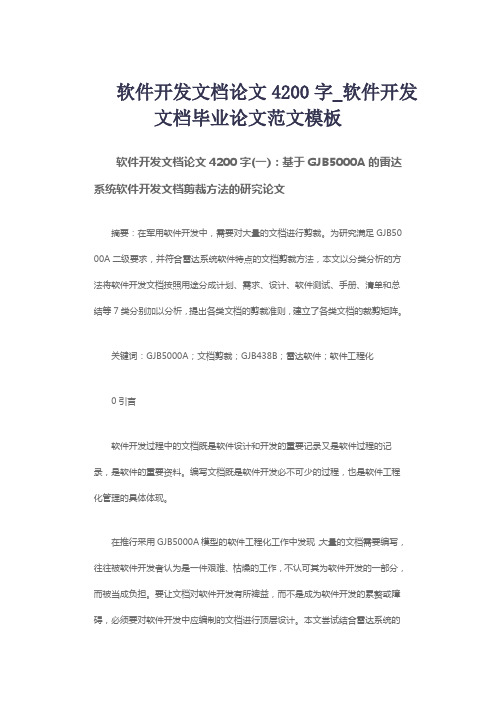
软件开发文档论文4200字_软件开发文档毕业论文范文模板软件开发文档论文4200字(一):基于GJB5000A的雷达系统软件开发文档剪裁方法的研究论文摘要:在军用软件开发中,需要对大量的文档进行剪裁。
为研究满足GJB5000A二级要求,并符合雷达系统软件特点的文档剪裁方法,本文以分类分析的方法将软件开发文档按照用途分成计划、需求、设计、软件测试、手册、清单和总结等7类分别加以分析,提出各类文档的剪裁准则,建立了各类文档的裁剪矩阵。
关键词:GJB5000A;文档剪裁;GJB438B;雷达软件;软件工程化0引言软件开发过程中的文档既是软件设计和开发的重要记录又是软件过程的记录,是软件的重要资料。
编写文档既是软件开发必不可少的过程,也是软件工程化管理的具体体现。
在推行采用GJB5000A模型的软件工程化工作中发现,大量的文档需要编写,往往被软件开发者认为是一件艰难、枯燥的工作,不认可其为软件开发的一部分,而被当成负担。
要让文档对软件开发有所裨益,而不是成为软件开发的累赘或障碍,必须要对软件开发中应编制的文档进行顶层设计。
本文尝试结合雷达系统的特点,将雷达系统软件开发过程中要产生的文档分成了7类分类,对不同类别的文档加以分析。
通过分析,得出适用于雷达系统软件开发的文档剪裁方法,也为其他领域的软件开发文档剪裁提供了参考。
1软件开发文档的分类GJB438B-2009规定了军用软件开发文档的通用要求。
在GJB438B标准中,规定了软件开发中可能产生的28种文档。
这些文档以类似瀑布模型的顺序列出,每种文档都是对软件或软件开发过程某一方面的描述[1]。
雷达系统是一种重要的军用设备,在雷达系统软件的开发过程中产生的文档应按照GJB438B的要求编写。
在推行采用GJB5000A模型的软件工程化工作中,为便于对文档规定的理解和对文档进行剪裁,基于GJB438B-2009标准的要求,将软件开发文档分为7类。
1.1计划类文档正如GJB9001B《质量管理体系要求》所指出的,PDCA(策划-实施-检查-处置)的方法适用于所有过程[2]。
- 1、下载文档前请自行甄别文档内容的完整性,平台不提供额外的编辑、内容补充、找答案等附加服务。
- 2、"仅部分预览"的文档,不可在线预览部分如存在完整性等问题,可反馈申请退款(可完整预览的文档不适用该条件!)。
- 3、如文档侵犯您的权益,请联系客服反馈,我们会尽快为您处理(人工客服工作时间:9:00-18:30)。
7.3软件测试计划(STP)
说明:
1.《软件测试计划》(STP)描述对计算机软件配置项CSCI,系统或子系统进行合格性测试的计划安排。
内容包括进行测试的环境、测试工作的标识及测试工作的时间安排等。
2.通常每个项目只有一个STP,使得需方能够对合格性测试计划的充分性作出评估。
软件测试计划的正文的格式如下:
1引言
本章应分成以下几条。
1.1标识
本条应包含本文档适用的系统和软件的完整标识,(若适用)包括标识号、标题、缩略词语、版本号和发行号。
1.2系统概述
本条应简述本文档适用的系统和软件的用途。
它应描述系统与软件的一般性质;概述系统开发、运行和维护的历史;标识项目的投资方、需方、用户、开发方和支持机构;标识当前和计划的运行现场;并列出其他有关文档。
1.3文档概述
本条应概括本文档的用途与内容,并描述与其使用有关的保密性或私密性要求。
1.4与其他计划的关系
(若有)本条应描述本计划和有关的项目管理计划之间的关系。
1.5基线
给出编写本软件测试计划的输入基线,如软件需求规格说明。
2引用文件
本章应列出本文档引用的所有文档的编号、标题、修订版本和日期。
本章还应标识不能通过正常的供货渠道获得的所有文档的来源。
3软件测试环境
本章应分条描述每一预计的测试现场的软件测试环境。
可以引用软件开发计划(SDP)中所描述的资源。
3.x(测试现场名称)
本条应标识一个或多个用于测试的测试现场,并分条描述每个现场的软件测试环境。
如果所有测试可以在一个现场实施,本条及其子条只给出一次。
如果多个测试现场采用相同或相似的软件测试环境,则应在一起讨论。
可以通过引用前面的描述来减少测试现场说明信息的重复。
3.x.1软件项
(若适用)本条应按名字、编号和版本标识在测试现场执行计划测试活动所需的软件项(如操作系统、编译程序、通信软件、相关应用软件、数据库、输入文件、代码检查程序、动态路径分析程序、测试驱动程序、预处理器、测试数据产生器、测试控制软件、其他专用测试软件和后处理器等)。
本条应描述每个软件项的用途、媒体(磁带、盘等),标识那些期望由现场提供的软件项,标识与软件项有关的保密措施或其他保密性与私密性问题。
3.x.2硬件及固件项
(若适用)本条应按名字、编号和版本标识在测试现场用于软件测试环境中的计算机硬件、接口设备、通信设备、测试数据归约设备、仪器设备(如附加的外围设备(磁带机、打印机、绘图仪)、测试消息生成器、测试计时设备和测试事件记录仪等)和固件项。
本条应描述每项的用途,陈述每项所需的使用时间与数量,标识那些期望由现场提供的项,标识与这些项有关的保密措施或其他保密性与私密性问题。
3.x.3其他材料
本条应标识并描述在测试现场执行测试所需的任何其他材料。
这些材料可包括手册、软件清单、被测试软件的媒体、测试用数据的媒体、输出的样本清单和其他表格或说明。
本条应标识需交付给现场的项和期望由现场提供的项。
(若适用)本描述应包括材料的类型、布局和数量。
本条应标识与这些项有关的保密措施或其他保密性与私密性问题。
3.x.4所有权种类、需方权利与许可证
本条应标识与软件测试环境中每个元素有关的所有权种类、需方权利与许可证等问题。
3.x.5安装、测试与控制
本条应标识开发方为执行以下各项工作的计划,可能需要与测试现场人员共同合作:
a.获取和开发软件测试环境中的每个元素;
b.使用前,安装与测试软件测试环境中的每项;
c.控制与维护软件测试环境中的每项.
3.x.6参与组织
本条应标识参与现场测试的组织和它们的角色与职责。
3.x.7人员
本条应标识在测试阶段测试现场所需人员的数量、类型和技术水平,需要他们的日期与时间,及任何特殊需要,如为保证广泛测试工作的连续性与一致性的轮班操作与关键技能的保持。
3.x.8定向计划
本条应描述测试前和测试期间给出的任何定向培训。
此信息应与3.x.7所给的人员要求有关。
培训可包括用户指导、操作员指导、维护与控制组指导和对全体人员定向的简述。
如果预料有大量培训的话,可单独制定一个计划而在此引用。
3.x.9要执行的测试
本条应通过引用第4章来标识测试现场要执行的测试。
4计划
本章应描述计划测试的总范围并分条标识,并且描述本STP适用的每个测试。
4.1总体设计
本条描述测试的策略和原则,包括测试类型和测试方法等信息。
4.1.1测试级
本条所描述要执行的测试的级别,例如:CSCI级或系统级。
4.1.2测试类别
本条应描述要执行的测试的类型或类别(例如,定时测试、错误输入测试、最大容量测试)。
4.1.3一般测试条件
本条应描述运用于所有测试或一组测试的条件,例如:“每个测试应包括额定值、最大值和最小值;”“每个x类型的测试都应使用真实数据(live data);”“应度量每个CSCI执行的规模与时间。
”并对要执行的测试程度和对所选测试程度的原理的陈述。
测试程度应表示为某个已定义总量(如离散操作条件或值样本的数量)的百分比或其他抽样方法。
也应包括再测试/回归测试所遵循的方法。
4.1.4测试过程
在渐进测试或累积测试情况下,本条应解释计划的测试顺序或过程。
4.1.5数据记录、归约和分析
本条应标识并描述在本STP中标识的测试期间和测试之后要使用的数据记录、归纳和分析过程。
(若适用)这些过程包括记录测试结果、将原始结果处理为适合评价的形式,以及
保留数据归约与分析结果可能用到的手工、自动、半自动技术。
4.2计划执行的测试
本条应分条描述计划测试的总范围。
4.2.x(被测试项)
本条应按名字和项目唯一标识符标识一个CSCI、子系统、系统或其他实体,并分以下几条描述对各项的测试。
4.2.x.y(测试的项目唯一标识符)
本条应由项目唯一标识符标识一个测试,并为该测试提供下述测试信息。
根据需要可引用4.1中的一般信息。
a.测试对象;
b.测试级;
c.测试类型或类别;
d.需求规格说明中所规定的合格性方法;
e.本测试涉及的CSCI需求(若适用)和软件系统需求的标识符(此信息亦可在第6章中提供);
f.特殊需求(例如,设备连续工作48小时、测试程度、特殊输入或数据库的使用);
g.测试方法,包括要用的具体测试技术,规定分析测试结果的方法。
h.要记录的数据的类型;
i.要采用的数据记录/归约/分析的类型;
j.假设与约束,如由于系统或测试条件即时间、接口、设备、人员、数据库等的原因而对测试产生的预期限制;
k.与测试有关的安全性、保密性与私密性要求。
4.3测试用例
a.测试用例的名称和标识;
b.简要说明本测试用例涉及的测试项和特性;
c.输入说明,规定执行本测试用例所需的各个输入,规定所有合适的数据库、文件、终端信息、内存常驻区域和由系统传送的值,规定各输入间所需的所有关系(如时序关系等);
d.输出说明,规定测试项的所有输出和特性(如:响应时间),提供各个输出或特性的正确值;
e.环境要求,见本文档第3章。
5测试进度表
本章应包含或引用指导实施本计划中所标识测试的进度表。
包括:
a.描述测试被安排的现场和指导测试的时间框架的列表或图表。
b.每个测试现场的进度表,(若适用)它可按时间顺序描述以下所列活动与事件,根据需要可附上支持性的叙述。
1)分配给测试主要部分的时间和现场测试的时间,
2)现场测试前,用于建立软件测试环境和其他设备、进行系统调试、定向培训和熟
悉工作所需的时间;
3)测试所需的数据库/数据文件值、输入值和其他操作数据的集合;
4)实施测试,包括计划的重测试;
5)软件测试报告(STR)的准备、评审和批准。
6需求的可追踪性
本章应包括:
a.从本计划所标识的每个测试到它所涉及的CSCI需求和(若适用)软件系统需求的可追
踪性(此可追踪性亦可在4.2.x.y中提供,而在此引用)。
b.从本测试计划所覆盖的每个CSCI需求和(若适用)软件系统需求到针对它的测试的可追踪性。
这种可追踪性应覆盖所有适用的软件需求规格说明(SRS)和相关接口需求规格说明(IRS)中的CSCI需求,对于软件系统,还应覆盖所有适用的系统/子系统规格说明(SSS)及相关系统级IRS中的系统需求。
7评价
7.1评价准则
7.2数据处理
7.3结论
8注解
本章应包含有助于理解本文档的一般信息(例如背景信息、词汇表、原理)。
本章应包含为理解本文档需要的术语和定义,所有缩略语和它们在文档中的含义的字母序列表。
附录
附录可用来提供那些为便于文档维护而单独出版的信息(例如图表、分类数据)。
为便于处理,附录可单独装订成册。
附录应按字母顺序(A, B等)编排。
